Pioneer VSX-921: instruction
Class: Household, kitchen appliances, electronics and equipment
Type: Home Theater System
Manual for Pioneer VSX-921
Table of contents
- IMPORTANT
- Contents
- Before you start
- Remote control
- Connecting your equipment
- Placing the speakers Connecting the speakers
- Bi-amping your speakers Installing your speaker system
- Selecting the Speaker system About the audio connection About the video converter
- About HDMI
- Connecting your TV and playback components Connecting your DVD player with no HDMI output
- Connecting an HDD/DVD recorder, BD recorder and other video sources
- Connecting a satellite/cable receiver or other set-top box Connecting other audio components
- MULTI-ZONE setup Sub Zone Input functions available Sub Zone Input functions available Connecting AM/FM antennas
- Connecting to the network through LAN interface Connecting to a wireless LAN Plugging in the receiver
- Basic Setup Canceling the demo display Automatically conducting optimum sound tuning (Full Auto MCACC)
- Operation Mode Setup
- Operable functions/ Descriptions Page
- Basic playback Playing a source Listening in surround sound Playing an iPod
- Listening to the radio Playing a USB device
- Playback with HOME MEDIA GALLERY inputs Bluetooth ADAPTER for Wireless Enjoyment of Music
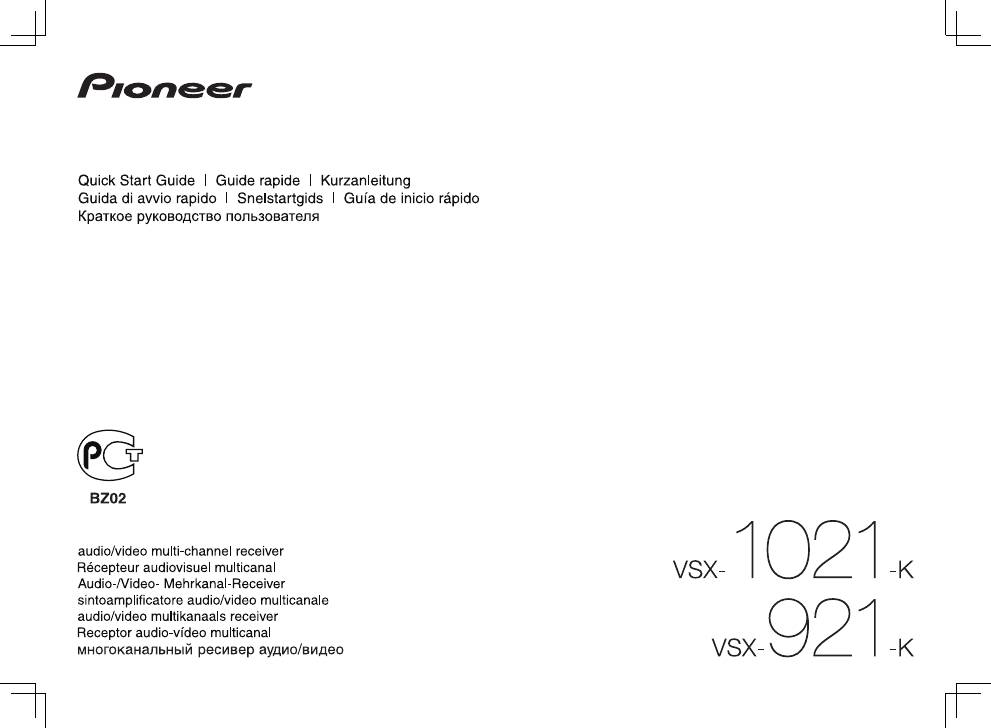

En
2
The exclamation point within an equilateral
triangle is intended to alert the user to the
presence of important operating and
maintenance (servicing) instructions in the
literature accompanying the appliance.
The lightning flash with arrowhead symbol,
within an equilateral triangle, is intended to
alert the user to the presence of uninsulated
“dangerous voltage” within the product’s
enclosure that may be of sufficient
magnitude to constitute a risk of electric
shock to persons.
CAUTION:
TO PREVENT THE RISK OF ELECTRIC
SHOCK, DO NOT REMOVE COVER (OR
BACK). NO USER-SERVICEABLE PARTS
INSIDE. REFER SERVICING TO QUALIFIED
SERVICE PERSONNEL.
CAUTION
RISK OF ELECTRIC SHOCK
DO NOT OPEN
IMPORTANT
D3-4-2-1-1_A1_En
WARNING
This equipment is not waterproof. To prevent a fire or
shock hazard, do not place any container filled with
liquid near this equipment (such as a vase or flower
pot) or expose it to dripping, splashing, rain or
moisture.
D3-4-2-1-3_A1_En
WARNING
Before plugging in for the first time, read the following
section carefully.
The voltage of the available power supply differs
according to country or region. Be sure that the
power supply voltage of the area where this unit
will be used meets the required voltage (e.g., 230 V
or 120 V) written on the rear panel.
D3-4-2-1-4*_A1_En
WARNING
To prevent a fire hazard, do not place any naked flame
sources (such as a lighted candle) on the equipment.
D3-4-2-1-7a_A1_En
VENTILATION CAUTION
When installing this unit, make sure to leave space
around the unit for ventilation to improve heat radiation
(at least 40 cm at top, 10 cm at rear, and 20 cm at each
side).
WARNING
Slots and openings in the cabinet are provided for
ventilation to ensure reliable operation of the product,
and to protect it from overheating. To prevent fire
hazard, the openings should never be blocked or
covered with items (such as newspapers, table-cloths,
curtains) or by operating the equipment on thick carpet
or a bed.
D3-4-2-1-7b*_A1_En
Operating Environment
Operating environment temperature and humidity:
+5 °C to +35 °C (+41 °F to +95 °F); less than 85 %RH
(cooling vents not blocked)
Do not install this unit in a poorly ventilated area, or in
locations exposed to high humidity or direct sunlight (or
strong artificial light)
D3-4-2-1-7c*_A1_En
If the AC plug of this unit does not match the AC
outlet you want to use, the plug must be removed
and appropriate one fitted. Replacement and
mounting of an AC plug on the power supply cord of
this unit should be performed only by qualified
service personnel. If connected to an AC outlet, the
cut-off plug can cause severe electrical shock. Make
sure it is properly disposed of after removal.
The equipment should be disconnected by removing
the mains plug from the wall socket when left unused
for a long period of time (for example, when on
vacation).
D3-4-2-2-1a_A1_En
CAUTION
The
STANDBY/ON
switch on this unit will not
completely shut off all power from the AC outlet.
Since the power cord serves as the main disconnect
device for the unit, you will need to unplug it from the
AC outlet to shut down all power. Therefore, make
sure the unit has been installed so that the power
cord can be easily unplugged from the AC outlet in
case of an accident. To avoid fire hazard, the power
cord should also be unplugged from the AC outlet
when left unused for a long period of time (for
example, when on vacation).
D3-4-2-2-2a*_A1_En
This product is for general household purposes. Any
failure due to use for other than household purposes
(such as long-term use for business purposes in a
restaurant or use in a car or ship) and which requires
repair will be charged for even during the warranty
period.
K041_A1_En
D3-4-2-1-2-2*_A2_En
Replacement and mounting of an AC plug on the power supply cord of this unit should be performed only by qualified
service personnel.
IMPORTANT: THE MOULDED PLUG
This appliance is supplied with a moulded three pin mains plug for your safety and convenience. A 10 amp fuse is fitted in this plug.
Should the fuse need to be replaced, please ensure that the replacement fuse has a rating of 10 amps and that it is approved by ASTA or BSI
to BS1362.
Check for the ASTA mark
or the BSI mark
on the body of the fuse.
If the plug contains a removable fuse cover, you must ensure that it is refitted when the fuse is replaced. If you lose the fuse cover the plug
must not be used until a replacement cover is obtained. A replacement fuse cover can be obtained from your local dealer.
If the fitted moulded plug is unsuitable for your socket outlet, then the fuse shall be removed and the plug cut off and disposed of
safely. There is a danger of severe electrical shock if the cut off plug is inserted into any 13 amp socket.
If a new plug is to be fitted, please observe the wiring code as shown below. If in any doubt, please consult a qualified electrician.
IMPORTANT: The wires in this mains lead are coloured in accordance with the following code:
Blue : Neutral Brown : Live
As the colours of the wires in the mains lead of this appliance may not correspond with the coloured markings identifying the terminals in
your plug, proceed as follows;
The wire which is coloured BLUE must be connected to the terminal which is marked with the
letter
N
or coloured BLACK.
The wire which is coloured BROWN must be connected to the terminal which is marked with the
letter
L
or coloured RED.
How to replace the fuse:
Open the fuse compartment with a screwdriver and replace the fuse.
Information for users on collection and disposal of old equipment and used batteries
These symbols on the products, packaging, and/or accompanying documents mean
that used electrical and electronic products and batteries should not be mixed with
general household waste.
For proper treatment, recovery and recycling of old products and used batteries,
please take them to applicable collection points in accordance with your national
legislation.
By disposing of these products and batteries correctly, you will help to save valuable
resources and prevent any potential negative effects on human health and the
environment which could otherwise arise from inappropriate waste handling.
For more information about collection and recycling of old products and batteries,
please contact your local municipality, your waste disposal service or the point of sale
where you purchased the items.
These symbols are only valid in the European Union.
For countries outside the European Union:
If you wish to discard these items, please contact your local authorities or dealer and
ask for the correct method of disposal.
K058a_A1_En
Symbol examples
for batteries
Symbol for
equipment
Pb

En
3
Thank you for buying this Pioneer product. This
Quick Start Guide includes instructions for basic
connections and operations to allow simple
use of the receiver. For detailed descriptions of
the receiver, see the “Operating Instructions”
provided on the included CD-ROM. The operating
instructions can also be downloaded from the
Pioneer website (http://www.pioneer.eu).
When using a Mac OS, place the CD-ROM in a
CD drive and then double-click on the CD-ROM
icon to find the PDF file (Operating Instructions).
Contents
01 Before you start
Checking what’s in the box ............................ 4
Loading the batteries ...................................... 4
About using AVNavigator
(included CD-ROM) ........................................ 4
Remote control ............................................... 5
02 Connecting your equipment
Connecting your equipment .......................... 6
Determining the speakers’ application ........ 6
Placing the speakers ...................................... 7
Connecting the speakers ............................... 7
Installing your speaker system ...................... 8
Selecting the Speaker system ....................... 9
About the audio connection .......................... 9
About the video converter .............................. 9
About HDMI .................................................. 10
Connecting your TV and playback
components .................................................. 11
Connecting an HDD/DVD recorder, BD
recorder and other video sources ............... 12
Connecting a satellite/cable receiver or
other set-top box ........................................... 13
Connecting other audio components ......... 13
Connecting AM/FM antennas ..................... 14
MULTI-ZONE setup ....................................... 14
Connecting to the network through
LAN interface ................................................ 15
Connecting to a wireless LAN ..................... 15
Plugging in the receiver ............................... 15
03 Basic Setup
Canceling the demo display ........................ 16
Automatically conducting optimum
sound tuning (Full Auto MCACC) ............... 16
Operation Mode Setup ................................. 17
04 Basic playback
Playing a source ........................................... 19
Listening in surround sound ....................... 19
Playing an iPod ............................................. 19
Playing a USB device ................................... 20
Listening to the radio .................................... 20
Playback with HOME MEDIA GALLERY
inputs ............................................................. 21
Bluetooth
ADAPTER for Wireless
Enjoyment of Music ...................................... 21
Flow of settings on the receiver
Flow for connecting and setting the receiver
The unit is a full-fledged AV receiver equipped with an abundance of functions and terminals. It can
be used easily after following the procedure below to make the connections and settings.
Required setting item
:
1
,
2
,
3
,
4
,
5
,
7
,
9
!
These items are included in this Quick Start Guide.
Setting to be made as necessary
:
6
,
8
,
10
,
11
,
12
!
These items are explained in the “Operating Instructions” provided on the included CD-ROM.
Important
The receiver’s initial settings can be made
on the computer using
Wiring Navi
on the
AVNavigator CD-ROM included with the
receiver. In this case, virtually the same con-
nections and settings as in steps
2
,
3
,
4
,
5
,
6
,
7
and
8
can be made interactively. For instruc-
tions on using AVNavigator, see
About using
AVNavigator (included CD-ROM)
on page 4 .
1 Before you start
!
Checking what’s in the box
on page 4
!
Loading the batteries
on page 4
j
2 Determining the speakers’ application
(page 6)
!
7.1 channel surround system (Front height)
!
7.1 channel surround system (Front wide)
!
7.1 channel surround system & Speaker B
connection
!
5.1 channel surround system & Front Bi-
amping connection (High quality surround)
!
5.1 channel surround system & ZONE 2
connection (Multi Zone)
j
3 Connecting the speakers
!
Placing the speakers
on page 7
!
Connecting the speakers
on page 7
!
Installing your speaker system
on page 8
!
Bi-amping your speakers
on page 8
j
4 Connecting the components
!
About the audio connection
on page 9
!
About the video converter
on page 9
!
Connecting your TV and playback components
on page 11
!
Connecting AM/FM antennas
on page 14
!
Plugging in the receiver
on page 15
j
5 Power On
j
6 Changing the OSD display language
(OSD Language)
j
7 MCACC speaker settings
!
Automatically conducting optimum sound
tuning (Full Auto MCACC)
on page 16
j
8 The Input Setup menu
(When using connections other than the recom-
mended connections)
j
9 Basic playback (page 19)
j
10 Adjusting the sound and picture
quality as desired
!
Using the various listening modes
!
Better sound using Phase Control
!
Measuring the all EQ type (SYMMETRY/ALL
CH ADJ/FRONT ALIGN)
!
Changing the channel level while listening
!
Switching on/off the Acoustic Calibration
EQ, Auto Sound Retriever or Dialog
Enhancement
!
Setting the PQLS function
!
Setting the Audio options
!
Setting the Video options
j
11 Other optional adjustments and
settings
!
Control with HDMI function
!
The Advanced MCACC menu
!
The System Setup and Other Setup menus
j
12 Making maximum use of the remote
control
!
Operating multiple receivers
!
Setting the remote to control other
components
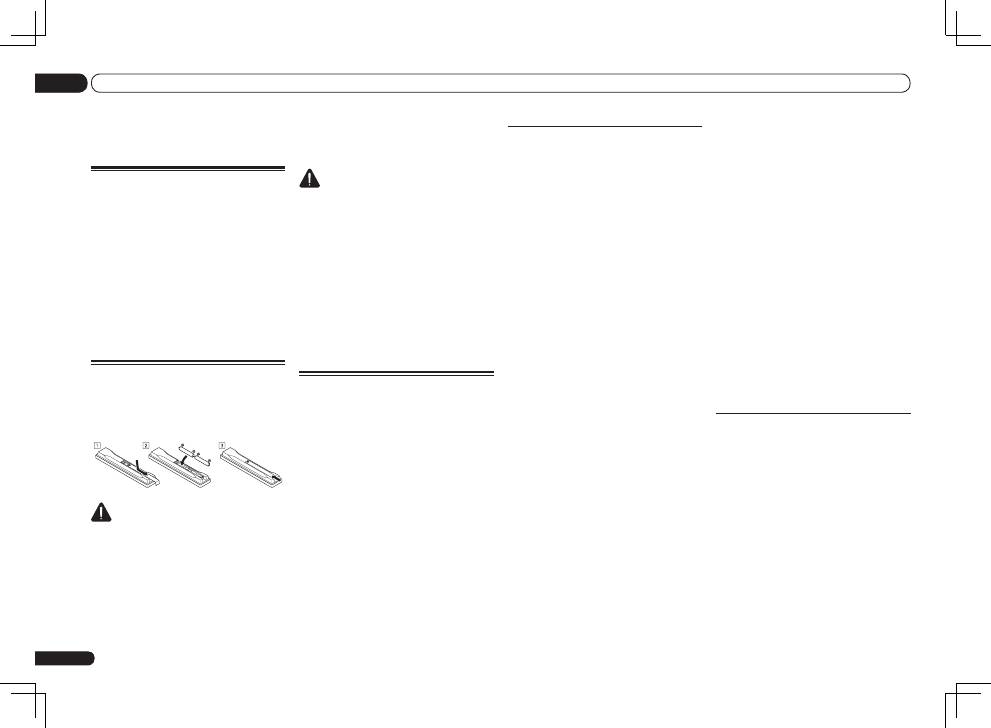
Installing AVNavigator
1 Load the included AVNavigator
CD-ROM into your computer’s CD drive.
!
The installation screen is displayed. Proceed
to step 2.
!
If the installation screen does not appear,
double-click on the CD-ROM icon then start
the installer (AVNV_XXX_xxx.exe).
2 Follow the instructions on the screen
to install.
When “Finish” is selected, installation is
completed.
3 Remove the included AVNavigator
CD-ROM from the computer’s CD drive.
Handling the CD-ROM
Operating Environment
!
This CD-ROM can be used with Microsoft
®
Windows
®
XP/Vista/7.
!
A browser is at times used for AVNavigator
functions. The supported browser is Microsoft
Internet Explorer 6, 7 and 8. With other
browsers, some functions may be limited or
the display may not appear properly.
Precautions For Use
!
This CD-ROM is for use with a personal
computer. It cannot be used with a DVD
player or music CD player. Attempting to play
this CD-ROM with a DVD player or music
CD player can damage speakers or cause
impaired hearing due to the large volume.
License
!
Please agree to the “Terms of Use” indicated
below before using this CD-ROM. Do not use if
you are unwilling to consent to the terms of its
use.
Terms of Use
!
Copyright to data provided on this CD-ROM
belongs to PIONEER CORPORATION.
Unauthorized transfer, duplication, broadcast,
public transmission, translation, sales,
lending or other such matters that go beyond
the scope of “personal use” or “citation” as
defined by Copyright Law may be subject
to punitive actions. Permission to use this
CD-ROM is granted under license by PIONEER
CORPORATION.
General Disclaimer
!
PIONEER CORPORATION does not
guarantee the operation of this CD-ROM with
respect to personal computers using any
of the applicable OS. In addition, PIONEER
CORPORATION is not liable for any damages
incurred as a result of use of this CD-ROM
and is not responsible for any compensation.
The names of private corporations, products
and other entities described herein are the
registered trademarks or trademarks of their
respective firms.
Using AVNavigator
1 Click [AVNavigator] on the desktop to
launch AVNavigator.
AVNavigator is launched and
Wiring Navi
starts up. The language selection screen
appears. Follow the instructions on the screen
to make the connections and automatic
settings.
Wiring Navi
only starts up automatically the
first time AVNavigator is launched.
2 Select and use the desired function.
AVNavigator includes the following functions:
!
Wiring Navi
– Guides you through
connections and initial settings in dialog
fashion. High precision initial settings can be
made easily.
En
4
01
Before you start
Before you start
Checking what’s in the box
Please check that you’ve received the following
supplied accessories:
!
Setup microphone (cable: 5 m)
!
Remote control unit
!
AAA size IEC R03 dry cell batteries (to confirm
system operation) x2
!
AM loop antenna
!
FM wire antenna
!
iPod cable
!
Power cord
!
Warranty card
!
CD-ROM (AVNavigator)
!
These quick start guide
Loading the batteries
The batteries included with the unit are to check
initial operations; they may not last over a long
period. We recommend using alkaline batteries
that have a longer life.
WARNING
!
Do not use or store batteries in direct sunlight
or other excessively hot place, such as inside a
car or near a heater. This can cause batteries
to leak, overheat, explode or catch fire. It
can also reduce the life or performance of
batteries.
CAUTION
Incorrect use of batteries may result in such
hazards as leakage and bursting. Observe the
following precautions:
!
Never use new and old batteries together.
!
Insert the plus and minus sides of the
batteries properly according to the marks in
the battery case.
!
Batteries with the same shape may have
different voltages. Do not use different
batteries together.
!
When disposing of used batteries, please
comply with governmental regulations or
environmental public instruction’s rules that
apply in your country or area.
About using AVNavigator
(included CD-ROM)
The included AVNavigator CD-ROM contains
Wiring Navi
allowing you to easily make the
receiver’s connections and initial settings in
dialog fashion. High precision initial settings
can be completed easily simply by following the
instructions on the screen to make the connec-
tions and settings.
There are also other features enabling easy use
of various functions, including an Interactive
Manual that operates in association with the
receiver, updating of various types of software,
and MCACC Application that lets you check the
MCACC measurement results on 3D graphs.
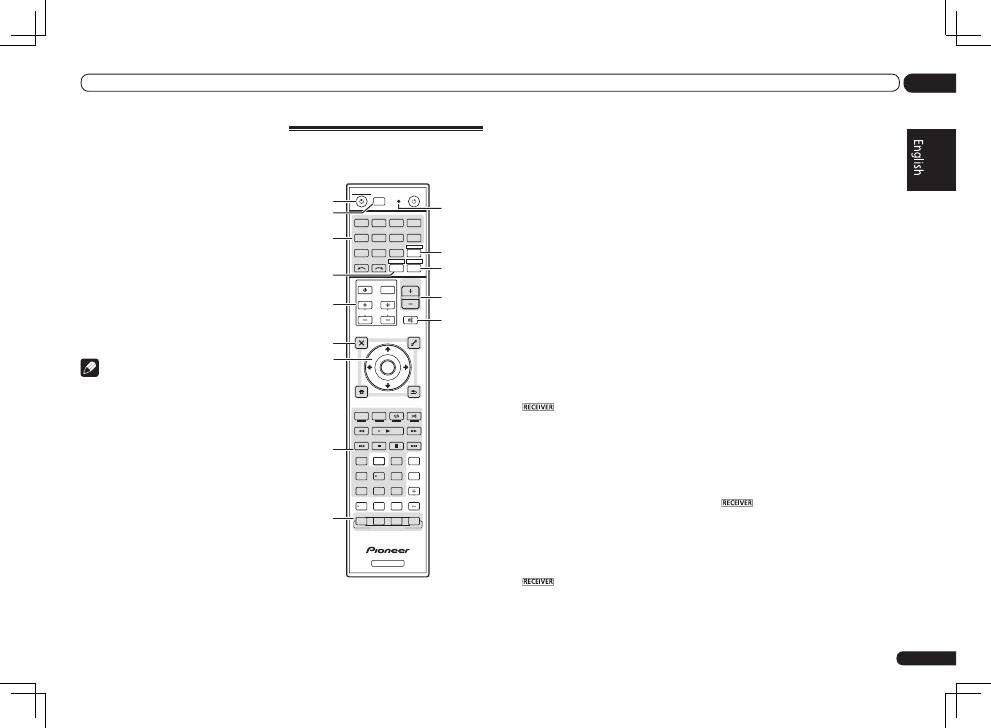
En
5
01
Before you start
!
Interactive Manual
– Automatically displays
the pages explaining the functions that have
been operated on the receiver. It is also
possible to operate the receiver from the
Interactive Manual.
!
Glossary
– Displays glossary pages.
!
MCACC Appli
– Displays Advanced
MCACC measurement results vividly on the
computer.
There are special operating instructions
for MCACC Application. These instructions
are included in the AVNavigator
Interactive Manual
’s menus. Refer to them
when using MCACC Application.
!
Software Update
– Allows various types of
software to be updated.
!
Settings
– Used to make various
AVNavigator settings.
!
Detection
– Used to detect the receiver.
Note
To use the AVNavigator of another model, first
uninstall (delete) this receiver’s AVNavigator,
then install the AVNavigator of the other model.
Deleting the AVNavigator
You can use the following method to uninstall
(delete) the AVNavigator from your PC.
%
Delete from the Control Panel of the
PC.
From the Start menu, click “Program”
d
“PIONEER CORPORATION”
d
“AVNavigator(VSX-1021 or VSX-921)”
d
“Uninstall”.
Remote control
This section explains how to operate the remote
control for the receiver.
RECEIVER
D.ACCESS
CH LEVEL A.ATT
LISTENING MODE
DIMMER
SIGNAL SEL MCACC SLEEP
TV / DTV
MPX
PQLS
PHASE CTRL
STATUS
PGM
iPod CTRL
HOME
MENU
TUNE
TUNE TOOLS
LIST
CH
TV CONTROL
INPUT
INPUT SELECT
iPod
USB
SAT
TUNER
VIDEO
TV CTRL
ZONE 2
ADPT
CD
TV
RCU SETUP
SOURCE
RECEIVER MULTI
OPERATION
BDR
BD
DVD
DVR
HMG
HDMI
RECEIVER
MUTE
MASTER
VOLUME
VOL
PRESET
TOP MENU
BAND
GUIDE
T.EDIT
VIDEO
PARAMETER
AUDIO
PARAMETER
ENTER
PRESET
RETURN
PTY
SEARCH
MENU
AUTO / ALC /
DIRECT
STEREO STANDARD ADV SURR
AUDIO
INFO
CLASS
ENTER
DISP
HDD
DVD
5
4
6
8
0
7
9
1
3
/ CLR
CH
22
S.RETRIEVER
2
1
2,3
4
5
9
10
6
7
8
11
13
12
14
15
The remote has been conveniently color-coded
according to component control using the follow-
ing system:
!
White
– Receiver control, TV control
!
Blue
– Other controls (See the Operating
Instructions in CD-ROM for detail.)
1
u
RECEIVER
This switches between standby and on for this
receiver.
2 MULTI OPERATION
Use this button to perform multi operations.
3 RCU SETUP
Use to input the preset code when making
remote control settings and to set the remote
control mode.
4 Input function buttons
Press to select control of other components.
Use
INPUT SELECT
c
/
d
to select the input
function (page 19).
5 ZONE 2
Switch to perform operations in
ZONE 2
.
6 TV CONTROL buttons
These buttons are dedicated to control the TV
assigned to the
TV CTRL
button.
7 Receiver setting buttons
Press
first to access:
!
AUDIO PARAMETER
– Use to access the
Audio options.
!
VIDEO PARAMETER
– Use to access the
Video options.
!
HOME MENU
– Use to access the Home
Menu.
!
RETURN
– Press to confirm and exit the
current menu screen.
8
i
/
j
/
k
/
l
/ENTER
Use the arrow buttons when setting up your
surround sound system and the Audio or Video
options.
9 Receiver Control buttons
Press
first to access:
!
PHASE CTRL
– Press to switch on/off Phase
Control.
!
STATUS
– Press to check selected receiver
settings.
!
PQLS
– Press to select the PQLS setting.
!
S.RETRIEVER
– Press to restore CD quality
sound to compressed audio sources.
!
SIGNAL SEL
– Use to select an input signal.
!
MCACC
– Press to switch between MCACC
presets.
!
SLEEP
– Use to put the receiver in sleep
mode and select the amount of time before
sleep.
!
CH LEVEL
– Press repeatedly to select a
channel, then use
k
/
l
to adjust the level.
!
A.ATT
– Attenuates (lowers) the level of an
analog input signal to prevent distortion.
!
DIMMER
– Dims or brightens the display.
10 LISTENING MODE controls
!
AUTO/ALC/DIRECT
– Switches between
Auto Surround, Auto Level Control mode and
Stream Direct mode.
!
STEREO
– Press to select stereo playback
mode.
!
STANDARD
– Press for Standard decoding
and to switch various modes (
2
Pro Logic,
Neo:6, etc.) (page 19).
!
ADV SURR
– Use to switch between the
various surround modes (page 19).
11 Remote control LED
Lights when a command is sent from the
remote control.
12 TV CTRL
Set the preset code of your TV’s manufacturer
when controlling the TV.
13
Switches the remote to control the receiver
(used to select the white commands).
Switch to perform operations in the main zone.
Also use this button to set up surround sound.
14 MASTER VOLUME +/–
Use to set the listening volume.
15 MUTE
Mutes the sound or restores the sound if it has
been muted (adjusting the volume also restores
the sound).
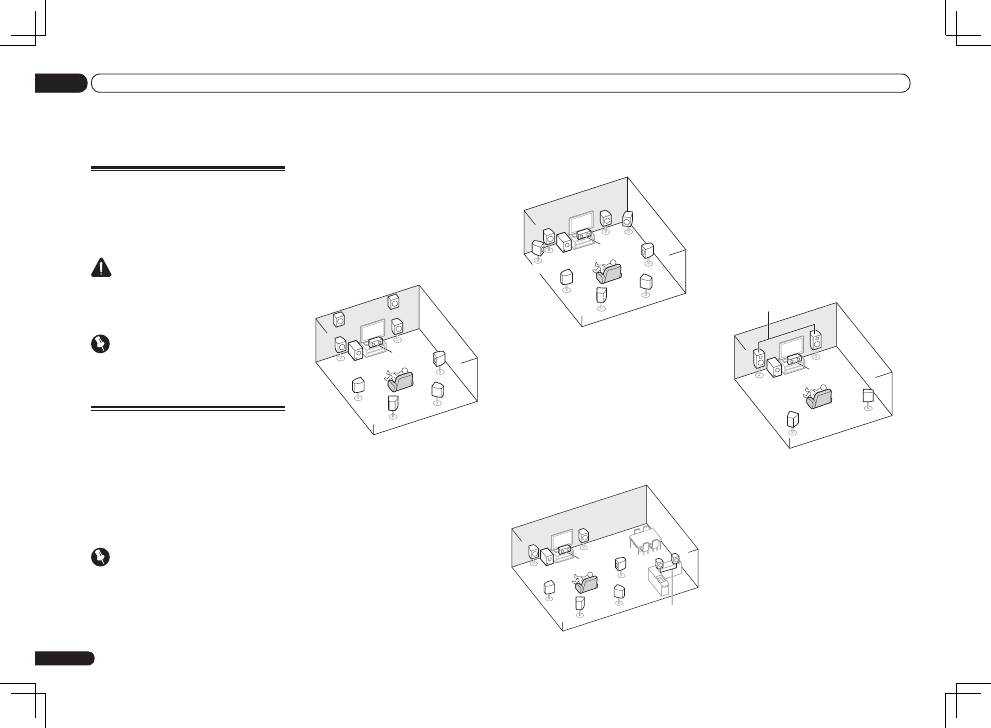
Connecting your equipment
This receiver provides you with many connec-
tion possibilities, but it doesn’t have to be dif-
ficult. This chapter explains the kinds of compo-
nents you can connect to make up your home
theater system.
CAUTION
Before making or changing the connections,
switch off the power and disconnect the power
cord from the power outlet. Plugging in should
be the final step.
Important
Illustration shows the VSX-1021, however con-
nections for the VSX-921 are the same except
where noted.
Determining the speakers’
application
This unit permits you to build various surround
systems, in accordance with the number of
speakers you have.
!
Be sure to connect speakers to the front left
and right channels (
L
and
R
).
!
It is also possible to only connect one of the
surround back speakers (
SB
) or neither.
Choose one from Plans [A] to [E] below.
Important
!
The
Speaker System
setting must be made if
you use any of the connections shown below
other than [A] (see
Speaker system setting
on
Operating Instructions in CD-ROM).
!
Sound does not come through simultaneously
from the front height, front wide, speaker B
and surround back speakers. Output speakers
are different depending on the input signal or
listening mode.
[A] 7.1 channel surround system (Front
height)
*Default setting
!
Speaker System
setting:
Normal(SB/FH)
SL
L
FHL
SW
C
R
FHR
SR
SBL
SBR
A 7.1 ch surround system connects the left and
right front speakers (
L
/
R
), the center speaker
(
C
), the left and right front height speakers
(
FHL
/
FHR
), the left and right surround speakers
(
SL
/
SR
), the left and right surround back speak-
ers (
SBL
/
SBR
), and the subwoofer (
SW
).
It is not possible to produce sound simultane-
ously from the front height or front wide speak-
ers and the surround back speakers.
This surround system produces a more true-to-
life sound from above.
En
6
02
Connecting your equipment
Connecting your equipment
[B] 7.1 channel surround system (Front
wide)
!
Speaker System
setting:
Normal(SB/FW)
FWR
FWL
SL
L
SW
C
R
SR
SBL
SBR
This plan replaces the left and right front height
speakers shown in [A] with the left and right
front wide speakers (
FWL
/
FWR
).
It is not possible to produce sound simultane-
ously from the front height or front wide speak-
ers and the surround back speakers.
This surround system produces a true-to-life
sound over a wider area.
[C] 7.1 channel surround system & Speaker
B connection
!
Speaker System
setting:
Speaker B
SL
L
SW
C
R
SR
SBL
SBR
L
R
Speaker B
With these connections you can simultaneously
enjoy 5.1-channel surround sound in the main
zone with stereo playback of the same sound
on the B speakers. The same connections also
allow for 7.1-channel surround sound in the
main zone when not using the B speakers.
[D] 5.1 channel surround system & Front
Bi-amping connection (High quality
surround)
!
Speaker System
setting:
Front Bi-Amp
Bi-amping connection of the front speakers for
high sound quality with 5.1-channel surround
sound.
L
R
SL
SW
C
SR
Front Bi-Amp
[E] 5.1 channel surround system & ZONE 2
connection (Multi Zone)
!
Speaker System
setting:
ZONE 2
With these connections you can simultaneously
enjoy 5.1-channel surround sound in the main
zone with stereo playback on another compo-
nent in ZONE 2. (The selection of input devices
is limited.)
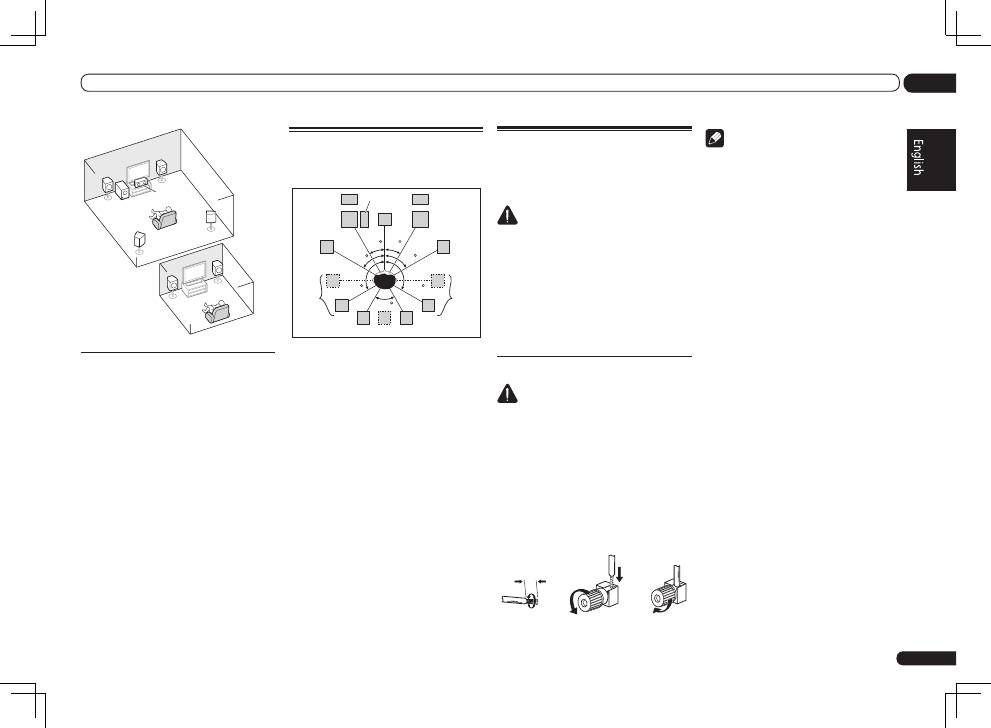
En
7
02
Connecting your equipment
L
L
R
R
SL
SW
C
SR
Main zone
Sub zone
ZONE 2
Other speaker connections
!
Your favorite speaker connections can be
selected even if you have fewer than 5.1
speakers (except front left/right speakers).
!
When not connecting a subwoofer, connect
speakers with low frequency reproduction
capabilities to the front channel. (The
subwoofer’s low frequency component
is played from the front speakers, so the
speakers could be damaged.)
!
After connecting, be sure to conduct the
Full Auto MCACC
(speaker environment
setting) procedure. See
Automatically
conducting optimum sound tuning (Full Auto
MCACC)
on page 16 .
Placing the speakers
Refer to the chart below for placement of the
speakers you intend to connect.
L
SW
C
FHL
FWL
SL
SBL
SBR
SB
SR
FWR
R
FHR
30 30
60
60
60
120
120
!
Place the surround speakers at 120º from
the center. If you, (1) use the surround
back speaker, and, (2) don’t use the front
height speakers / front wide speakers, we
recommend placing the surround speaker
right beside you.
!
If you intend to connect only one surround
back speaker, place it directly behind you.
!
Place the left and right front height speakers
at least one meter directly above the left and
right front speakers.
Connecting the speakers
Each speaker connection on the receiver com-
prises a positive (+) and negative (–) terminal.
Make sure to match these up with the terminals
on the speakers themselves.
CAUTION
!
These speaker terminals carry
HAZARDOUS
LIVE
voltage. To prevent the risk of electric
shock when connecting or disconnecting the
speaker cables, disconnect the power cord
before touching any uninsulated parts.
!
Make sure that all the bare speaker wire is
twisted together and inserted fully into the
speaker terminal. If any of the bare speaker
wire touches the back panel it may cause the
power to cut off as a safety measure.
Bare wire connections
CAUTION
Make sure that all speakers are securely
installed. This not only improves sound quality,
but also reduces the risk of damage or injury
resulting from speakers being knocked over or
falling in the event of external shocks such as
earthquakes.
1 Twist exposed wire strands together.
2 Loosen terminal and insert exposed
wire.
3 Tighten terminal.
1
2
3
10 mm
Note
!
Please refer to the manual that came with
your speakers for details on how to connect
the other end of the speaker cables to your
speakers.
!
Use an RCA cable to connect the subwoofer.
It is not possible to connect using speaker
cables.
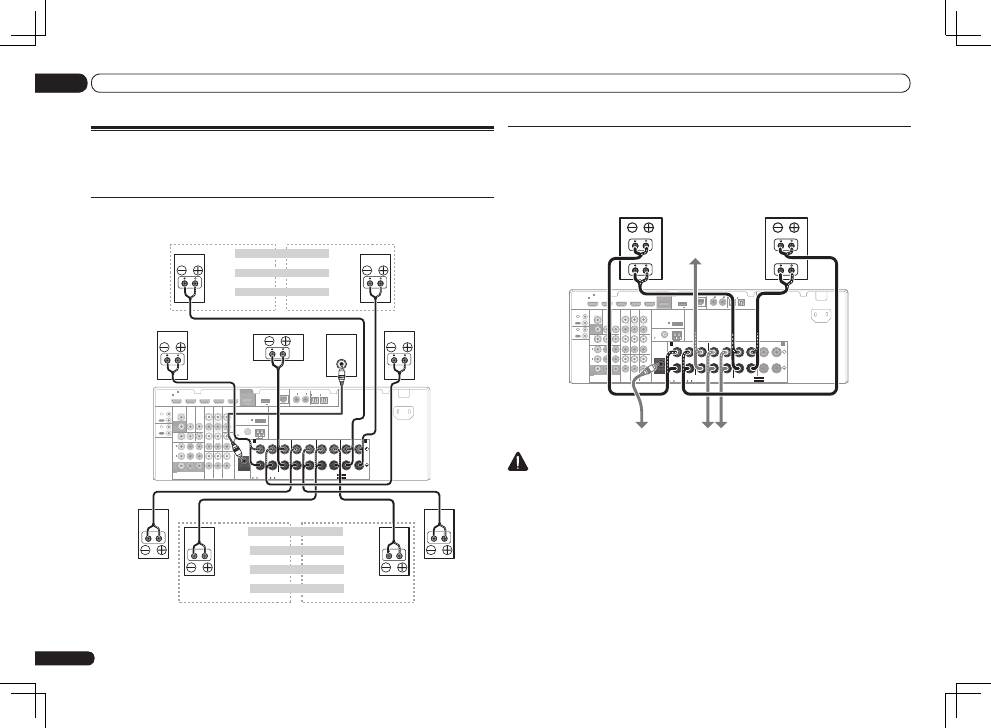
En
8
02
Connecting your equipment
Bi-amping your speakers
Bi-amping is when you connect the high frequency driver and low frequency driver of your speakers
to different amplifiers for better crossover performance. Your speakers must be bi-ampable to do
this (having separate terminals for high and low) and the sound improvement will depend on the
kind of speakers you’re using.
HDMI
VIDEO
CONTROL
IR
COMPONENT VIDEO
VIDEO IN
TV/SAT
IN
ZONE 2
DVR/BDR CD-R/TAPE ZONE 2
DVR/
BDR
OUT
OUT
DVD IN
IN
IN
IN
IN
CD
L
R
L
R
IN
L
R
OUT
OUT
VIDEO
IN
DVD IN
BD IN
DVR/BDR IN
FM UNBAL
75
FRONT
CENTER
SURROUND
SURROUND BACK / ZONE 2
R
L
R
L
R
L
R
L
(Single)
AM LOOP
(
CD
)
(
DVD
)
TV/SAT VIDEO
DVD
Y
P
B
P
R
(
DVR/BDR
)
(
TV/SAT
)
COAXIAL
(10/100)
LAN
AUDIO
PRE OUT
SPEAKERS
ANTENNA
OPTICAL
ASSIGN
ABLE
ASSIGNABLE
ASSIGNABLE
OUT
MONITOR
OUT
MONITOR
OUT
SUBWOOFER
IN
1
(DVD)
IN
1
(DVR/
BDR)
IN
2
ASSIGNABLE
1
IN
1
IN
2
IN
1
IN
2
SEE INSTRUCTION MANUAL
SELECTABLE
SELECTABLE
VOIR LE MODE D’EMPLOI
CAUTION:
SPEAKER IMPEDANCE
6 -16 .
ATTENTION:
ENCEINTE D’IMPEDANCE DE
6 -16 .
FRONT HEIGHT / WIDE /
B
A
OUT
IN
OUT
IN
DC OUTPUT
for WIRELESS LAN
(OUTPUT 5 V
0.1 A MAX)
ADAPTER PORT
(OUTPUT 5 V 0.6 A MAX)
AC IN
High
Low
High
Low
Front right
Front left
Bi-amp compatible
speaker
Subwoofer
Bi-amp compatible
speaker
Center
Surround right
Surround left
CAUTION
!
Most speakers with both
High
and
Low
terminals have two metal plates that connect the
High
to the
Low
terminals. These must be removed when you are bi-amping the speakers or you could
severely damage the amplifier. See your speaker manual for more information.
!
If your speakers have a removable crossover network, make sure you do not remove it for bi-amping.
Doing so may damage your speakers.
Installing your speaker system
At the very least, front left and right speakers only are necessary. Note that your main surround
speakers should always be connected as a pair, but you can connect just one surround back
speaker if you like (it must be connected to the left surround back terminal).
Standard surround connection
HDMI
VIDEO
CONTROL
IR
COMPONENT VIDEO
VIDEO IN
TV/SAT
IN
ZONE 2
DVR/BDR CD-R/TAPE ZONE 2
DVR/
BDR
OUT
OUT
DVD IN
IN
IN
IN
IN
CD
L
R
L
R
IN
L
R
OUT
OUT
VIDEO
IN
DVD IN
BD IN
DVR/BDR IN
FM UNBAL
75
FRONT
CENTER
SURROUND
SURROUND BACK / ZONE 2
R
L
R
L
R
L
R
L
(Single)
AM LOOP
(
CD
)
(
DVD
)
TV/SAT VIDEO
DVD
Y
P
B
P
R
(
DVR/BDR
)
(
TV/SAT
)
COAXIAL
(10/100)
LAN
AUDIO
PRE OUT
SPEAKERS
ANTENNA
OPTICAL
ASSIGN
ABLE
ASSIGNABLE
ASSIGNABLE
OUT
MONITOR
OUT
MONITOR
OUT
SUBWOOFER
IN
1
(DVD)
IN
1
(DVR/
BDR)
IN
2
ASSIGNABLE
1
IN
1
IN
2
IN
1
IN
2
SEE INSTRUCTION MANUAL
SELECTABLE
SELECTABLE
VOIR LE MODE D’EMPLOI
CAUTION:
SPEAKER IMPEDANCE
6 -16 .
ATTENTION:
ENCEINTE D’IMPEDANCE DE
6 -16 .
FRONT HEIGHT / WIDE /
B
A
OUT
IN
OUT
IN
DC OUTPUT
for WIRELESS LAN
(OUTPUT 5 V
0.1 A MAX)
ADAPTER PORT
(OUTPUT 5 V 0.6 A MAX)
AC IN
LINE LEVEL
INPUT
The front height terminals can also be used
for the front wide and Speaker B speakers.
Front height setting
Front height right
Front height left
Front wide setting
Front wide right
Front wide left
Speaker B setting
Speaker B - right
Speaker B - left
Front right
Center
Subwoofer
Front left
The surround back terminals can also be
used for ZONE 2.
Surround left
5.1 ch surround setting
Not connected
Not connected
6.1 ch surround setting
Not connected
Surround back
7.1 ch surround setting
Surround back right
Surround back left
ZONE 2 setting
ZONE 2 - Right
ZONE 2 - Left
Surround right
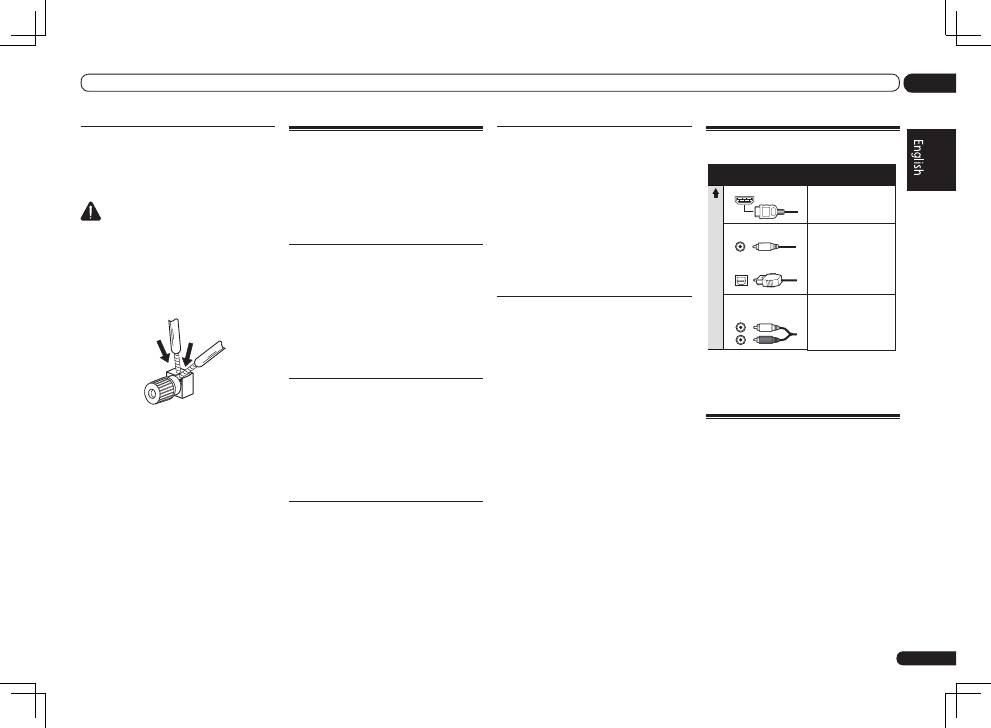
En
9
02
Connecting your equipment
Bi-wiring your speakers
Your speakers can also be bi-wired if they sup-
port bi-amping.
!
With these connections, the
Speaker System
setting makes no difference.
CAUTION
!
Don’t connect different speakers from the
same terminal in this way.
!
When bi-wiring as well, heed the cautions for
bi-amping shown above.
%
To bi-wire a speaker, connect two
speaker cords to the speaker terminal on
the receiver.
Selecting the Speaker system
The front height terminals can be used for front
wide and Speaker B connections, in addition to
for the front height speakers. Also, the surround
back terminals can be used for bi-amping and
ZONE 2 connections, in addition to for the sur-
round back speakers. Make this setting accord-
ing to the application.
Front height setup
*Default setting
1 Connect a pair of speakers to the front
height speaker terminals.
See
Standard surround connection
on page 8 .
2 If necessary, select ‘Normal(SB/FH)’
from the Speaker System menu.
See
Speaker system setting
on Operating
Instructions in CD-ROM to do this.
Front wide setup
1 Connect a pair of speakers to the front
height speaker terminals.
See
Standard surround connection
on page 8 .
2 Select ‘Normal(SB/FW)’ from the
Speaker System menu.
See
Speaker system setting
on Operating
Instructions in CD-ROM to do this.
Speaker B setup
You can listen to stereo playback in another
room.
1 Connect a pair of speakers to the front
height speaker terminals.
See
Standard surround connection
on page 8 .
2 Select ‘Speaker B’ from the
Speaker System menu.
See
Speaker system setting
on Operating
Instructions in CD-ROM to do this.
Bi-Amping setup
Bi-amping connection of the front speakers for
high sound quality with 5.1-channel surround
sound.
1 Connect bi-amp compatible speakers
to the front and surround back speaker
terminals.
See
Bi-amping your speakers
on page 8 .
2 Select ‘Front Bi-Amp’ from the
Speaker System menu.
See
Speaker system setting
on Operating
Instructions in CD-ROM to do this.
ZONE 2 setup
With these connections you can simultaneously
enjoy 5.1-channel surround sound in the main
zone with stereo playback on another compo-
nent in ZONE 2.
1 Connect a pair of speakers to the
surround back speaker terminals.
See
Standard surround connection
on page 8 .
2 Select ‘ZONE 2’ from the
Speaker System menu.
See
Speaker system setting
on Operating
Instructions in CD-ROM to do this.
About the audio connection
Transferable audio
signals
Sound signal priorit
y
HDMI
HD audio
Digital (Coaxial)
Conventional digital audio
RCA (Analog)
(
White
/
Red
)
Conventional analog audio
Digital (Optical)
Types of cables and
terminals
!
With an HDMI cable, video and audio signals
can be transferred in high quality over a single
cable.
About the video converter
The video converter ensures that all video
sources are output through all of the
MONITOR
VIDEO OUT
jacks. The only exception is HDMI:
since this resolution cannot be downsampled,
you must connect your monitor/TV to the
receiver’s HDMI output when connecting this
video source.
If several video components are assigned to the
same input function (see
The Input Setup menu
on Operating Instructions in CD-ROM), the
converter gives priority to HDMI, component,
then composite (in that order).
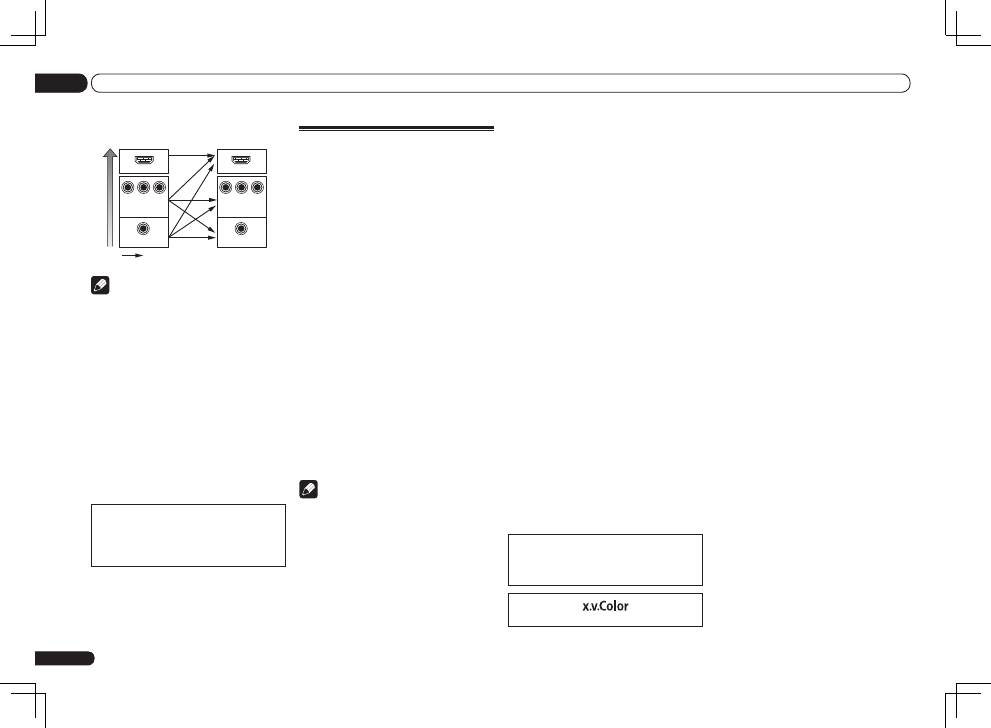
En
10
02
Connecting your equipment
!
If you connect a component that
is not compatible with HDCP, an
HDCP ERROR
message is displayed on the
front panel display. Some components that
are compatible with HDCP still cause this
message to be displayed, but so long as there
is no problem with displaying video this is not
a malfunction.
!
Depending on the component you have
connected, using a DVI connection may result
in unreliable signal transfers.
!
This receiver supports SACD, Dolby Digital
Plus, Dolby TrueHD and DTS-HD Master
Audio. To take advantage of these formats,
however, make sure that the component
connected to this receiver also supports the
corresponding format.
!
Use a High Speed HDMI
®
cable. If an HDMI
cable other than a High Speed HDMI
®
cable is
used, it may not work properly.
!
When an HDMI cable with a built-in equalizer
is connected, it may not operate properly.
!
Signal transfer is only possible when
connected to a compatible component.
!
HDMI format digital audio transmissions
require a longer time to be recognized. Due to
this, interruption in the audio may occur when
switching between audio formats or beginning
playback.
!
Turning on/off the device connected to this
unit’s
HDMI OUT
terminal during playback,
or disconnecting/connecting the HDMI
cable during playback, may cause noise or
interrupted audio.
HDMI, the HDMI logo and High-Definition
Multimedia Interface are trademarks or regis-
tered trademarks of HDMI Licensing, LLC in the
United States and other countries.
“x.v.Color” and
are trade-
marks of Sony Corporation.
VIDEO IN
VIDEO
MONITOR OUT
COMPONENT
VIDEO IN
Y
P
B
P
R
Y
P
B
P
R
COMPONENT VIDEO
MONITOR OUT
HDMI IN
HDMI OUT
High picture qualit
y
Video signals can be output
Terminal for connection with
source device
Terminal for connection
with TV monitor
Note
!
If the video signal does not appear on your
TV, try adjusting the resolution settings on
your component or display. Note that some
components (such as video game units) have
resolutions that may not be converted. In this
case, try switching Digital Video Conversion
(in
Setting the Video options
on Operating
Instructions in CD-ROM)
OFF
.
!
The signal input resolutions that can be
converted from the component video input
for the HDMI output are 480i/576i, 480p/576p,
720p and 1080i. 1080p signals cannot be
converted.
!
Only signals with an input resolution
of 480i/576i can be converted from the
component video input for the composite
MONITOR OUT
terminals.
This item incorporates copy protection technol-
ogy that is protected by U.S. patents and other
intellectual property rights of Rovi Corporation.
Reverse engineering and disassembly are
prohibited.
About HDMI
The HDMI connection transfers uncompressed
digital video, as well as almost every kind of
digital audio.
This receiver incorporates High-Definition
Multimedia Interface (HDMI
®
) technology.
This receiver supports the functions described
below through HDMI connections.
!
Digital transfer of uncompressed video
(contents protected by HDCP (1080p/24,
1080p/60, etc.))
!
3D signal transfer
!
Deep Color signal transfer
!
x.v.Color signal transfer
!
ARC (Audio Return Channel)
!
Input of multi-channel linear PCM digital
audio signals (192 kHz or less) for up to 8
channels
!
Input of the following digital audio formats:
—
Dolby Digital, Dolby Digital Plus, DTS, High
bitrate audio (Dolby TrueHD, DTS-HD Master
Audio, DTS-HD High Resolution Audio),
DVD-Audio, CD, SACD (DSD signal), Video
CD, Super VCD
!
Synchronized operation with components
using the
Control
with HDMI function (see
Control with HDMI function
on Operating
Instructions in CD-ROM)
Note
!
An HDMI connection can only be made
with DVI-equipped components compatible
with both DVI and High Bandwidth Digital
Content Protection (HDCP). If you choose to
connect to a DVI connector, you will need a
separate adaptor (DVI
d
HDMI) to do so. A DVI
connection, however, does not support audio
signals. Consult your local audio dealer for
more information.
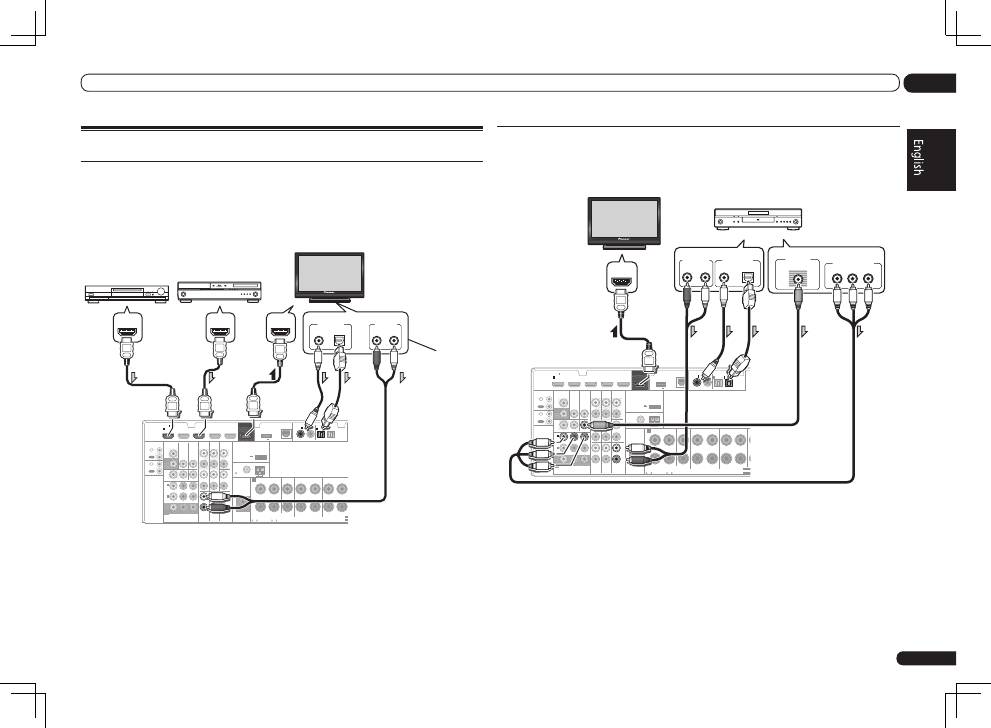
En
11
02
Connecting your equipment
Connecting your TV and playback components
Connecting using HDMI
If you have an HDMI or DVI (with HDCP) equipped component (Blu-ray Disc player (BD), etc.), you
can connect it to this receiver using a commercially available HDMI cable.
If the TV and playback components support the
Control
with HDMI feature, the convenient
Control
with HDMI functions can be used (see
Control with HDMI function
on Operating Instructions in
CD-ROM).
HDMI
VIDEO
CONTROL
IR
COMPONENT VIDEO
VIDEO IN
TV/SAT
IN
ZONE 2
DVR/BDR CD-R/TAPE ZONE 2
DVR/
BDR
OUT
OUT
DVD IN
IN
IN
IN
IN
CD
L
R
L
R
IN
L
R
OUT
OUT
VIDEO
IN
DVD IN
BD IN
DVR/BDR IN
FM UNBAL
75
FRONT
CENTER
SURROUND
SURROUND BACK / ZONE 2
R
L
R
L
R
L
(Single)
AM LOOP
(
CD
)
(
DVD
)
TV/SAT
VIDEO
DVD
Y
P
B
P
R
(
DVR/BDR
)
(
TV/SAT
)
COAXIAL
(10/100)
LAN
AUDIO
PRE OUT
SPEAKERS
ANTENNA
OPTICAL
ASSIGN
ABLE
ASSIGNABLE
ASSIGNABLE
OUT
MONITOR
OUT
MONITOR
OUT
SUBWOOFER
IN
1
(DVD)
IN
1
(DVR/
BDR)
IN
2
ASSIGNABLE
1
IN
1
IN
2
IN
1
IN
2
SEL
SEL
CAUTION:
SPEAKER IMPEDANCE
6 -16 .
ATTENTION:
ENCEINTE D’IMPEDANCE DE
6 -16 .
A
OUT
IN
OUT
IN
DC OUTPUT
for WIRELESS LAN
(OUTPUT 5 V
0.1 A MAX)
ADAPTER PORT
(OUTPUT 5 V 0.6 A MAX)
DIGITAL OUT
COAXIAL
OPTICAL
ANALOG
R
L
AUDIO OUT
HDMI IN
HDMI OUT
HDMI OUT
VSX-1021
only
HDMI/DVI-compatible
Blu-ray Disc player
Other HDMI/DVI-
equipped component
HDMI/DVI-compatible
monitor
Select one
This connection is
required in order to
listen to the sound of
the TV over the
receiver.
!
For input components, connections other than HDMI connections are also possible (see
Connecting your DVD player with no HDMI output
on page 11 ).
!
If you want to listen to the sound of the TV over the receiver, connect the receiver and TV with audio
cables.
—
When the TV and receiver are connected by HDMI connections, if the TV supports the HDMI ARC
(Audio Return Channel) function, the sound of the TV is input to the receiver via the
HDMI OUT
terminal, so there is no need to connect an audio cable. In this case, set
TV Audio
at
HDMI Setup
to
via HDMI
(see
HDMI Setup
on Operating Instructions in CD-ROM).
Connecting your DVD player with no HDMI output
This diagram shows connections of a TV (with HDMI input) and DVD player (or other playback com-
ponent with no HDMI output) to the receiver.
HDMI
VIDEO
CONTROL
IR
COMPONENT VIDEO
VIDEO IN
TV/SAT
IN
ZONE 2
DVR/BDR CD-R/TAPE ZONE 2
DVR/
BDR
OUT
OUT
DVD IN
IN
IN
IN
IN
CD
L
R
L
R
IN
L
R
OUT
OUT
VIDEO
IN
DVD IN
BD IN
DVR/BDR IN
FM UNBAL
75
FRONT
CENTER
SURROUND
SURROUND BACK / ZONE 2
R
L
R
L
R
L
(Single)
AM LOOP
(
CD
)
(
DVD
)
TV/SAT VIDEO
DVD
Y
P
B
P
R
(
DVR/BDR
)
(
TV/SAT
)
COAXIAL
(10/100)
LAN
AUDIO
PRE OUT
SPEAKERS
ANTENNA
OPTICAL
ASSIGN
ABLE
ASSIGNABLE
ASSIGNABLE
OUT
MONITOR
OUT
MONITOR
OUT
SUBWOOFER
IN
1
(DVD)
IN
1
(DVR/
BDR)
IN
2
ASSIGNABLE
1
IN
1
IN
2
IN
1
IN
2
SELECTA
SELECTA
CAUTION:
SPEAKER IMPEDANCE
6 -16 .
ATTENTION:
ENCEINTE D’IMPEDANCE DE
6 -16 .
FR
A
OUT
IN
OUT
IN
DC OUTPUT
for WIRELESS LAN
(OUTPUT 5 V
0.1 A MAX)
ADAPTER PORT
(OUTPUT 5 V 0.6 A MAX)
HDMI IN
ANALOG
R
AUDIO OUT
VIDEO OUT
VIDEO
Y
P
B
P
R
COMPONENT VIDEO OUT
DIGITAL OUT
COAXIAL
OPTICAL
L
HDMI/DVI-compatible
monitor
DVD player, etc.
Select one
Select one
!
If you want to listen to the sound of the TV over the receiver, connect the receiver and TV with audio
cables (page 11).
—
When the TV and receiver are connected by HDMI connections, if the TV supports the HDMI ARC
(Audio Return Channel) function, the sound of the TV is input to the receiver via the
HDMI OUT
terminal, so there is no need to connect an audio cable. In this case, set
TV Audio
at
HDMI Setup
to
via HDMI
(see
HDMI Setup
on Operating Instructions in CD-ROM).
!
If you use an optical digital audio cable, you’ll need to tell the receiver which digital input you
connected the player to (see
The Input Setup menu
on Operating Instructions in CD-ROM).
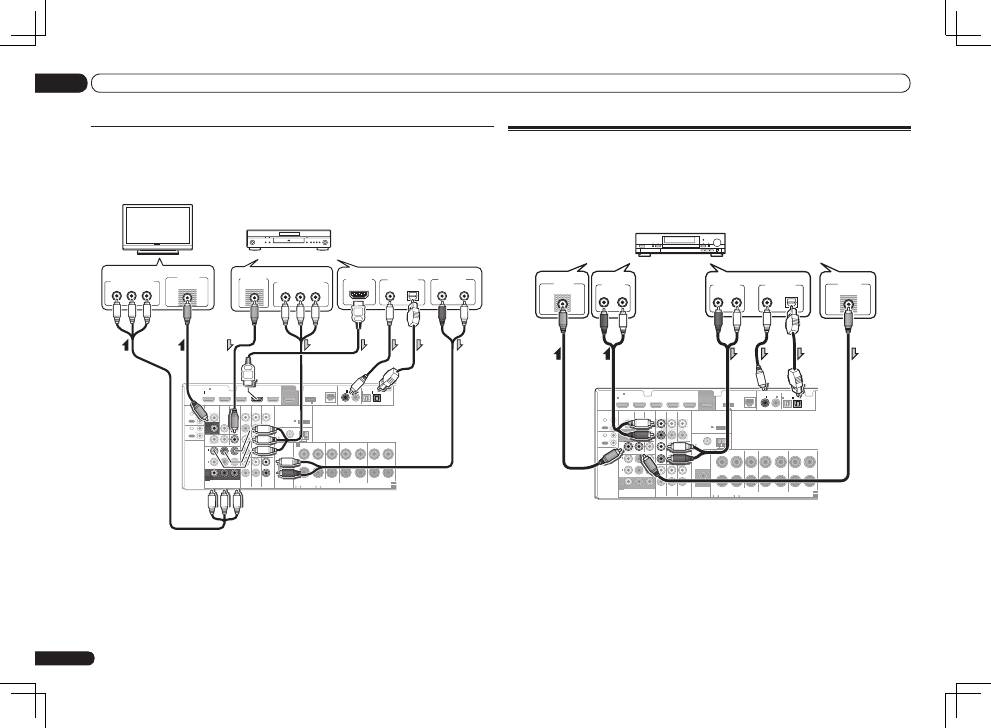
En
12
02
Connecting your equipment
Connecting an HDD/DVD recorder, BD recorder and other video
sources
This receiver has two sets of audio/video inputs and outputs suitable for connecting analog or digi-
tal video devices, including HDD/DVD recorders and BD recorders.
When you set up the receiver you’ll need to tell the receiver which input you connected the recorder
to (see also
The Input Setup menu
on Operating Instructions in CD-ROM).
HDMI
VIDEO
CONTROL
IR
COMPONENT VIDEO
VIDEO IN
TV/SAT
IN
ZONE 2
DVR/BDR
CD-R/TAPE ZONE 2
DVR/
BDR
OUT
OUT
DVD IN
IN
IN
IN
IN
CD
L
R
L
R
IN
L
R
OUT
OUT
VIDEO
IN
DVD IN
BD IN
DVR/BDR IN
FM UNBAL
75
FRONT
CENTER
SURROUND
SURROUND BACK / ZONE 2
R
L
R
L
R
L
(Single)
AM LOOP
(
CD
)
(
DVD
)
TV/SAT VIDEO
DVD
Y
P
B
P
R
(
DVR/BDR
)
(
TV/SAT
)
COAXIAL
(10/100)
LAN
AUDIO
PRE OUT
SPEAKERS
ANTENNA
OPTICAL
ASSIGN
ABLE
ASSIGNABLE
ASSIGNABLE
OUT
MONITOR
OUT
MONITOR
OUT
SUBWOOFER
IN
1
(DVD)
IN
1
(DVR/
BDR)
IN
2
ASSIGNABLE
1
IN
1
IN
2
IN
1
IN
2
SELEC
SELEC
CAUTION:
SPEAKER IMPEDANCE
6 -16 .
ATTENTION:
ENCEINTE D’IMPEDANCE DE
6 -16 .
A
OUT
IN
OUT
IN
DC OUTPUT
for WIRELESS LAN
(OUTPUT 5 V
0.1 A MAX)
ADAPTER PORT
(OUTPUT 5 V 0.6 A MAX)
DIGITAL OUT
COAXIAL
OPTICAL
ANALOG
R
L
ANALOG
R
L
AUDIO OUT
AUDIO IN
VIDEO OUT
VIDEO
VIDEO
VIDEO IN
HDD/DVD recorder, BD recorder, etc.
Select one
!
In order to record, you must connect the analog audio cables (the digital connection is for playback
only).
!
If your HDD/DVD recorder, BD recorder, etc., is equipped with an HDMI output terminal, we
recommend connecting it to the receiver’s
HDMI
DVR/BDR
IN
terminal. When doing so, also
connect the receiver and TV by HDMI (see
Connecting using HDMI
on page 11 ).
Connecting your TV with no HDMI input
This diagram shows connections of a TV (with no HDMI input) and DVD player (or other playback
component) to the receiver.
!
With these connections, the picture is not output to the TV even if the DVD player is connected with
an HDMI cable. Connect the DVD player’s video signals using a composite or component cord.
HDMI
VIDEO
CONTROL
IR
COMPONENT VIDEO
VIDEO IN
TV/SAT
IN
ZONE 2
DVR/BDR CD-R/TAPE ZONE 2
DVR/
BDR
OUT
OUT
DVD IN
IN
IN
IN
IN
CD
L
R
L
R
IN
L
R
OUT
OUT
VIDEO
IN
DVD IN
BD IN
DVR/BDR IN
FM UNBAL
75
FRONT
CENTER
SURROUND
SURROUND BACK / ZONE 2
R
L
R
L
R
L
(Single)
AM LOOP
(
CD
)
(
DVD
)
TV/SAT VIDEO
DVD
Y
P
B
P
R
(
DVR/BDR
)
(
TV/SAT
)
COAXIAL
(10/100)
LAN
AUDIO
PRE OUT
SPEAKERS
ANTENNA
OPTICAL
ASSIGN
ABLE
ASSIGNABLE
ASSIGNABLE
OUT
MONITOR
OUT
MONITOR
OUT
SUBWOOFER
IN
1
(DVD)
IN
1
(DVR/
BDR)
IN
2
ASSIGNABLE
1
IN
1
IN
2
IN
1
IN
2
SELEC
SELEC
CAUTION:
SPEAKER IMPEDANCE
6 -16 .
ATTENTION:
ENCEINTE D’IMPEDANCE DE
6 -16 .
A
OUT
IN
OUT
IN
DC OUTPUT
for WIRELESS LAN
(OUTPUT 5 V
0.1 A MAX)
ADAPTER PORT
(OUTPUT 5 V 0.6 A MAX)
ANALOG
R
AUDIO OUT
VIDEO IN
Y
P
B
P
R
COMPONENT VIDEO IN
VIDEO OUT
VIDEO
VIDEO
Y
P
B
P
R
COMPONENT VIDEO OUT
DIGITAL OUT
COAXIAL
OPTICAL
HDMI OUT
L
TV
DVD player, etc.
Select one
Select one
Select one
!
Connect using an HDMI cable to listen to HD audio on the receiver. Do not use an HDMI cable to
input video signals.
Depending on the video component, it may not be possible to output signals connected by HDMI
and other methods simultaneously, and it may be necessary to make output settings. Please refer
to the operating instructions supplied with your component for more information.
!
If you want to listen to the sound of the TV over the receiver, connect the receiver and TV with audio
cables (page 11).
!
If you use an optical digital audio cable, you’ll need to tell the receiver which digital input you
connected the player to (see
The Input Setup menu
on Operating Instructions in CD-ROM).
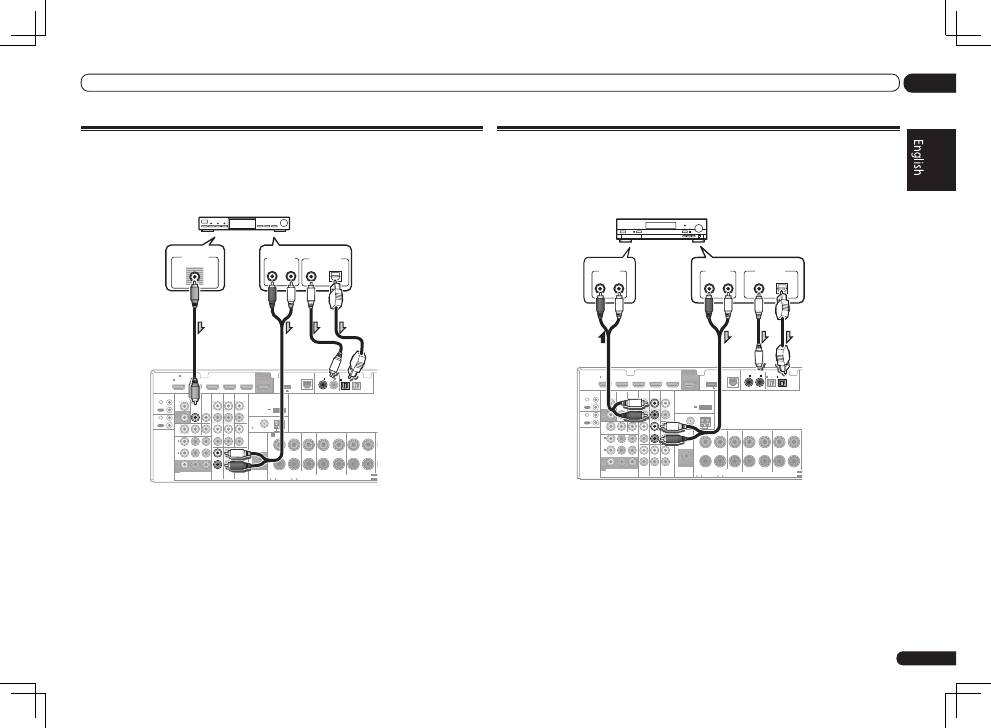
En
13
02
Connecting your equipment
Connecting a satellite/cable receiver or other set-top box
Satellite and cable receivers, and terrestrial digital TV tuners are all examples of so-called ‘set-top
boxes’.
When you set up the receiver you’ll need to tell the receiver which input you connected the set-top
box to (see
The Input Setup menu
on Operating Instructions in CD-ROM).
HDMI
VIDEO
CONTROL
IR
COMPONENT VIDEO
VIDEO IN
TV/SAT
IN
ZONE 2
DVR/BDR CD-R/TAPE ZONE 2
DVR/
BDR
OUT
OUT
DVD IN
IN
IN
IN
IN
CD
L
R
L
R
IN
L
R
OUT
OUT
VIDEO
IN
DVD IN
BD IN
DVR/BDR IN
FM UNBAL
75
FRONT
CENTER
SURROUND
SURROUND BACK / ZONE 2
R
L
R
L
R
L
(Single)
AM LOOP
(
CD
)
(
DVD
)
TV/SAT
VIDEO
DVD
Y
P
B
P
R
(
DVR/BDR
)
(
TV/SAT
)
COAXIAL
(10/100)
LAN
AUDIO
PRE OUT
SPEAKERS
ANTENNA
OPTICAL
ASSIGN
ABLE
ASSIGNABLE
ASSIGNABLE
OUT
MONITOR
OUT
MONITOR
OUT
SUBWOOFER
IN
1
(DVD)
IN
1
(DVR/
BDR)
IN
2
ASSIGNABLE
1
IN
1
IN
2
IN
1
IN
2
SELECT
SELECT
CAUTION:
SPEAKER IMPEDANCE
6 -16 .
ATTENTION:
ENCEINTE D’IMPEDANCE DE
6 -16 .
F
A
OUT
IN
OUT
IN
DC OUTPUT
for WIRELESS LAN
(OUTPUT 5 V
0.1 A MAX)
ADAPTER PORT
(OUTPUT 5 V 0.6 A MAX)
VIDEO OUT
VIDEO
ANALOG
R
AUDIO OUT
DIGITAL OUT
COAXIAL
OPTICAL
L
Select one
STB
!
VSX-1021 only:
If your set-top box is equipped with an HDMI output terminal, we recommend connecting it to the
receiver’s
HDMI
IN 1
terminal. When doing so, also connect the receiver and TV by HDMI (see
Connecting using HDMI
on page 11 ).
Connecting other audio components
This receiver has both digital and analog inputs, allowing you to connect audio components for
playback.
When you set up the receiver you’ll need to tell the receiver which input you connected the compo-
nent to (see also
The Input Setup menu
on Operating Instructions in CD-ROM).
HDMI
VIDEO
CONTROL
IR
COMPONENT VIDEO
VIDEO IN
TV/SAT
IN
ZONE 2
DVR/BDR
CD-R/TAPE
ZONE 2
DVR/
BDR
OUT
OUT
DVD IN
IN
IN
IN
IN
CD
L
R
L
R
IN
L
R
OUT
OUT
VIDEO
IN
DVD IN
BD IN
DVR/BDR IN
FM UNBAL
75
FRONT
CENTER
SURROUND
SURROUND BACK / ZONE 2
R
L
R
L
R
L
(Single)
AM LOOP
(
CD
)
(
DVD
)
TV/SAT VIDEO
DVD
Y
P
B
P
R
(
DVR/BDR
)
(
TV/SAT
)
COAXIAL
(10/100)
LAN
AUDIO
PRE OUT
SPEAKERS
ANTENNA
OPTICAL
ASSIGN
ABLE
ASSIGNABLE
ASSIGNABLE
OUT
MONITOR
OUT
MONITOR
OUT
SUBWOOFER
IN
1
(DVD)
IN
1
(DVR/
BDR)
IN
2
ASSIGNABLE
1
IN
1
IN
2
IN
1
IN
2
SELEC
SELEC
CAUTION:
SPEAKER IMPEDANCE
6 -16 .
ATTENTION:
ENCEINTE D’IMPEDANCE DE
6 -16 .
A
OUT
IN
OUT
IN
DC OUTPUT
for WIRELESS LAN
(OUTPUT 5 V
0.1 A MAX)
ADAPTER PORT
(OUTPUT 5 V 0.6 A MAX)
DIGITAL OUT
COAXIAL
OPTICAL
ANALOG
R
L
AUDIO OUT
ANALOG
R
L
AUDIO IN
CD-R, MD, DAT, etc.
Select one
!
If you’re connecting a recorder, connect the analog audio outputs to the analog audio inputs on the
recorder.
!
If your turntable has line-level outputs (i.e., it has a built-in phono pre-amp), connect it to the
CD
inputs instead.
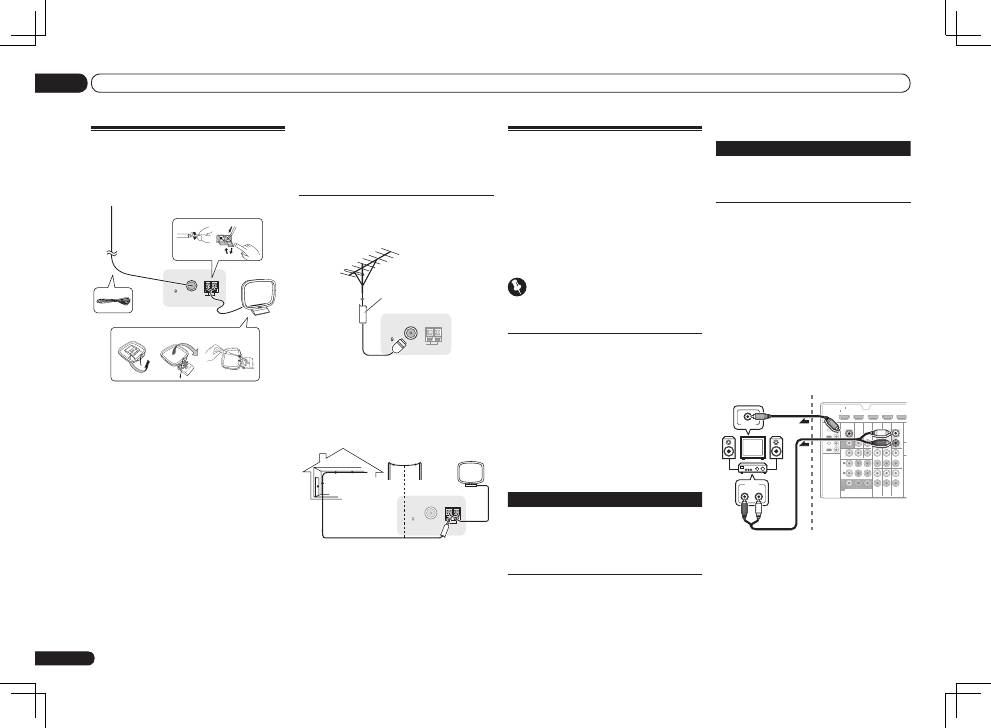
En
14
02
Connecting your equipment
MULTI-ZONE setup
This receiver can power up to two independent
systems in separate rooms after you have made
the proper MULTI-ZONE connections.
Different sources can be playing in two zones at
the same time or, depending on your needs, the
same source can also be used. The main and
sub zone have independent power (the main
zone power can be off while sub zone is on) and
the sub zone can be controlled by the remote or
front panel controls.
Important
VSX-921 model cannot connect the TV monitor
for sub zone.
Making MULTI-ZONE connections
It is possible to make these connections if you
have a separate TV and speakers for the sub
zone (
ZONE 2
). You will also need a separate
amplifier if you are not using the
MULTI-ZONE
setup using speaker terminals (ZONE 2)
on page
14 for the sub zone.
MULTI-ZONE listening options
The following table shows the signals that can
be output to ZONE 2:
In case of VSX-1021
Sub Zone Input functions available
ZONE 2
DVD
,
TV/SAT
,
DVR/BDR
,
VIDEO
,
HOME MEDIA GALLERY
,
iPod/USB
,
CD
,
CD-R/TAPE
,
TUNER
,
ADAPTER
PORT
(Outputs analog audio, composite
video.)
It is not possible to down-convert the audio
and video input signals from the
HDMI
input
terminals, digital input terminals (
OPTICAL
and
COAXIAL
) and the
COMPONENT VIDEO
input
terminals and output them to ZONE 2.
In case of VSX-921
Sub Zone
Input functions available
ZONE 2
DVD
,
TV/SAT
,
DVR/BDR
,
VIDEO 1
,
VIDEO 2
,
CD
,
CD-R/TAPE
,
TUNER
,
ADAPTER PORT
(Output analog audio only.)
It is not possible to down-convert the audio
input signal from the
HDMI
input terminals or
digital input terminals (
OPTICAL
and
COAXIAL
)
and output them to ZONE 2.
Basic MULTI-ZONE setup (ZONE 2)
1 Connect a separate amplifier to the
AUDIO ZONE 2 OUT jacks on this receiver.
You should have a pair of speakers attached to
the sub zone amplifier as shown in the follow-
ing illustration.
2
VSX-1021 only:
Connect a TV monitor
to the VIDEO ZONE 2 OUT jack on this
receiver.
HDMI
VIDEO
CONTROL
IR
COMPONENT VIDEO
VIDEO IN
TV/SAT
IN
ZONE 2
DVR/BDR CD-R/TAPE
ZONE 2
DVR/
BDR
OUT
OUT
DVD IN
IN
IN
IN
IN
CD
L
R
L
R
IN
L
R
OUT
OUT
VIDEO
IN
DVD IN
BD IN
DVR/BDR IN
FM
75
TV/SAT VIDEO
DVD
Y
P
B
P
R
AUDIO
AN
ASSIGN
ABLE
MONITOR
OUT
MONITOR
OUT
IN
1
(DVD)
IN
1
(DVR/
BDR)
IN
2
ASSIGNABLE
1
OUT
IN
OUT
IN
R
L
AUDIO IN
VIDEO IN
Sub zone (
ZONE 2
)
Main zone
VSX-1021
only
MULTI-ZONE setup using speaker
terminals (ZONE 2)
You must select
ZONE 2
in Speaker system
setting on Operating Instructions in CD-ROM to
use this setup.
Connecting AM/FM antennas
Connect the AM loop antenna and the FM wire
antenna as shown below. To improve reception
and sound quality, connect external antennas
(see
Connecting external antennas
on page 14 ).
FM UNBAL
75
AM LOOP
ANTENNA
3
1
4
fig. a
fig. b
fig. c
5
2
1 Pull off the protective shields of both
AM antenna wires.
2 Push open the tabs, then insert one
wire fully into each terminal, then release
the tabs to secure the AM antenna wires.
3 Fix the AM loop antenna to the
attached stand.
To fix the stand to the antenna, bend in the
direction indicated by the arrow (
fig. a
) then clip
the loop onto the stand (
fig. b
).
!
If you plan to mount the AM antenna to a
wall or other surface, secure the stand with
screws (
fig. c
) before clipping the loop to the
stand. Make sure the reception is clear.
4 Place the AM antenna on a flat
surface and in a direction giving the best
reception.
5 Connect the FM wire antenna into the
FM antenna socket.
For best results, extend the FM antenna fully
and fix to a wall or door frame. Don’t drape
loosely or leave coiled up.
Connecting external antennas
To improve FM reception, connect an external
FM antenna to
FM UNBAL 75
W
.
FM UNBAL
75
AM LOOP
ANTENNA
75 Ω coaxial cable
To improve AM reception, connect a 5 m to 6
m length of vinyl-coated wire to the
AM LOOP
terminals without disconnecting the supplied
AM loop antenna.
For the best possible reception, suspend hori-
zontally outdoors.
FM UNBAL
75
AM LOOP
ANTENNA
Outdoor antenna
Indoor antenna
(vinyl-coated wire)
5 m to 6 m

En
15
02
Connecting your equipment
1 Connect a pair of speakers to the
surround back speaker terminals.
2
VSX-1021 only:
Connect a TV monitor
to the VIDEO ZONE 2 OUT jack on this
receiver.
SURROUND
SURROUND BACK / ZONE 2
R
L
R
R
L
(Single)
(
CD
)
(
DVD
)
(
DVR/BDR
)
(
TV/SAT
)
COAXIAL
SPEAKERS
OPTICAL
ASSIGNABLE
ASSIGNABLE
IN
1
IN
2
IN
1
IN
2
SEE INST
SELECTABLE
SELECTABLE
VOIR LE M
FRONT HEIG
HDMI
VIDEO
CONTROL
IR
COMPONENT VI
VIDEO IN
TV/SAT
IN
ZONE 2
DVR/
BDR
OUT
OUT
IN
Y
P
B
ASSIGN
ABLE
MONITOR
OUT
MONITOR
OUT
IN
1
(DVD)
IN
1
(DVR/
BDR)
IN
2
ASSIGNABLE
1
OUT
IN
OUT
IN
VIDEO IN
R
L
VSX-1021
only
Sub zone (
ZONE 2
)
Main zone
Connecting to the network
through LAN interface
By connecting this receiver to the network via
the LAN terminal, you can listen to Internet
radio stations. To listen to Internet radio sta-
tions, you must sign a contract with an ISP
(Internet Service Provider) beforehand.
When connected in this way, you can play audio
files stored on the components on the network,
including your computer, using HOME MEDIA
GALLERY inputs.
UNBAL
FRONT
CENTER
R
L
AM LOOP
C
(10/100)
LAN
PRE OUT
TENNA
OUT
SUBWOOFER
CAUTION:
SPEAKER IMPEDANCE
6 -16 .
ATTENTION:
ENCEINTE D’IMPEDANCE DE
6 -16 .
A
DC OUTPUT
for WIRELESS LAN
(OUTPUT 5 V
0.1 A MAX)
ADAPTER PORT
(OUTPUT 5 V 0.6 A MAX)
WAN
3
2
1
LAN
Internet
Modem
Router
LAN cable
(sold separately)
to LAN port
PC
Connect the LAN terminal on this receiver to
the LAN terminal on your router (with or with-
out the built-in DHCP server function) with a
straight LAN cable (CAT 5 or higher).
Turn on the DHCP server function of your
router. In case your router does not have the
built-in DHCP server function, it is necessary
to set up the network manually. For details, see
Network Setup menu
on Operating Instructions
in CD-ROM.
LAN terminal specifications
!
LAN terminal : Ethernet jack
(10BASE-T/100BASE-TX)
Note
!
Refer to the operation manual of the
equipment you have as the connected
equipment and connection method may differ
depending on your Internet environment.
!
When using a broadband Internet connection,
a contract with an Internet service provider
is required. For more details, contact your
nearest Internet service provider.
Connecting to a wireless LAN
Wireless connection to the network is possible
through a wireless LAN connection. Use the
separately sold AS-WL300 for connection.
WAN
DC 5V
WPS
Ethernet
UNBAL
FRONT
CENTER
SURROUND
R
L
R
AM LOOP
(
CD
)
(
DVD
)
COAXIAL
PRE OUT
SPEA
TENNA
ASSIGNABL
OUT
SUBWOOFER
IN
1
IN
2
CAUTION:
SPEAKER IMPEDANCE
6 -16 .
ATTENTION:
ENCEINTE D’IMPEDANCE DE
6 -16 .
A
DC OUTPUT
for WIRELESS LAN
(OUTPUT 5 V
0.1 A MAX)
ADAPTER PORT
(OUTPUT 5 V 0.6 A MAX)
(10/100)
LAN
Internet
Modem
Wireless LAN converter (AS-WL300)
Router
Plugging in the receiver
Only plug in after you have connected all your
components to this receiver, including the
speakers.
CAUTION
!
Handle the power cord by the plug part. Do
not pull out the plug by tugging the cord, and
never touch the power cord when your hands
are wet, as this could cause a short circuit or
electric shock. Do not place the unit, a piece of
furniture, or other object on the power cord or
pinch the cord in any other way. Never make
a knot in the cord or tie it with other cables.
The power cords should be routed so that they
are not likely to be stepped on. A damaged
power cord can cause a fire or give you an
electric shock. Check the power cord once in a
while. If you find it damaged, ask your nearest
Pioneer authorized independent service
company for a replacement.
!
Do not use any power cord other than the one
supplied with this unit.
!
Do not use the supplied power cord for any
purpose other than that described below.
!
The receiver should be disconnected by
removing the mains plug from the wall
socket when not in regular use, e.g., when on
vacation.
1 Plug the supplied power cord into the
AC IN socket on the back of the receiver.
2 Plug the other end into a power outlet.
!
After this receiver is connected to an AC
outlet, a 2 second to 10 second HDMI
initialization process begins. You cannot
carry out any operations during this process.
The
HDMI
indicator in the front panel display
blinks during this process, and you can turn
on this receiver once it has stopped blinking.
When you set the
Control
with HDMI to
OFF
, you can skip this process. For details
about the
Control
with HDMI feature, see
Control with HDMI function
on Operating
Instructions in CD-ROM.
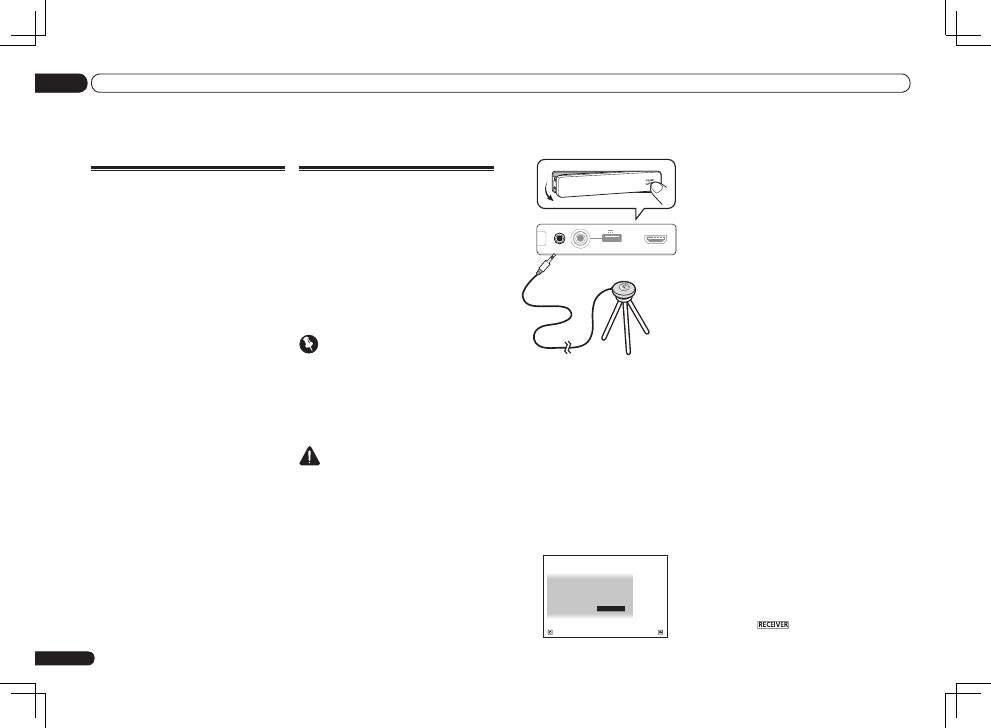
2 Connect the microphone to the MCACC
SETUP MIC jack on the front panel.
CONTROL
ON / OFF
MCACC
SETUP MIC
iPod
iPhone
iPad
USB
5V 2.1 A
HDMI 2 INPUT
Microphone
Tripod
Make sure there are no obstacles between the
speakers and the microphone.
If you have a tripod, use it to place the micro-
phone so that it’s about ear level at your
normal listening position. If you do not have
a tripod, use some other object to install the
microphone.
Install the microphone on a stable floor.
Placing the microphone on any of the following
surfaces may make accurate measurement
impossible:
!
Sofas or other soft surfaces.
!
High places such as tabletops and sofa tops.
The Full Auto MCACC display appears once the
microphone is connected.
Speaker System
: Normal(SB/FH)
1a.Full Auto MCACC
A/V RECEIVER
Exit
Return
START
EQ Type
: SYMMETRY
MCACC
: M1.MEMORY 1
THX Speaker
:
NO
!
If you leave the GUI screen for over five
minutes, the screen saver will appear.
3 Select the parameters you want to set.
!
When data measurement is taken, the
reverb characteristics data (both before- and
after-calibration) that this receiver had been
storing will be overwritten.
!
When measurement is taken of the reverb
characteristics data other than
SYMMETRY
,
the data are not measured after the
correction. If you will need to measure after
correcting data, take the measurement
using the
EQ Professional
menu in the
Manual MCACC
setup.
If the speakers are connected using any setup
other than
Normal(SB/FH)
, be sure to set
Speaker System
before the Full Auto MCACC
Setup. See
Speaker system setting
on Operating
Instructions in CD-ROM.
!
Speaker System
– Shows the current
settings. When this is selected and
ENTER
is
pressed, the speaker system selection screen
appears. Select the proper speaker system,
then press
RETURN
to return.
If you are planning on bi-amping your front
speakers, or setting up a separate speaker
system in another room, read through
Speaker system setting
on Operating
Instructions in CD-ROM and make sure to
connect your speakers as necessary before
continuing to step 4.
!
EQ Type
– This determines how the
frequency balance is adjusted.
!
MCACC
– The six MCACC presets are used
for storing surround sound settings for
different listening positions. Simply choose
an unused preset for now.
!
THX Speaker
– Select
YES
when using THX
speakers (all speakers other than the front
speakers are set to
SMALL
). In other cases,
leave at
NO
.
4 Press
then select START.
En
16
03
Basic Setup
Basic Setup
Canceling the demo display
On this receiver, the demo mode is turned on by
default. When the power is turned on, the demo
display is set and various indications are shown
on the front panel display. To cancel the demo
display, connect the power cord, then perform
the operation below.
!
The demo mode is canceled automatically
when the
Full Auto MCACC
operation is
performed.
1 Switch the receiver into standby.
2 While holding down ENTER on the
front panel, press
u
STANDBY/ON.
The display shows
RESET
c
NO
d
.
3 Select ‘FL DEMO’ using TUNE
i
/
j
.
4 Use PRESET
k
/
l
to select FL DEMO
c
OFF
d
then press ENTER on the front
panel.
Automatically conducting
optimum sound tuning (Full
Auto MCACC)
The Full Auto MCACC Setup measures the
acoustic characteristics of your listening area,
taking into account ambient noise, speaker
connection and speaker size, and tests for both
channel delay and channel level. After you have
set up the microphone provided with your sys-
tem, the receiver uses the information from a
series of test tones to optimize the speaker set-
tings and equalization for your particular room.
Important
!
Make sure the microphone and speakers are
not moved during the Full Auto MCACC Setup.
!
Using the Full Auto MCACC Setup will
overwrite any existing settings for the MCACC
preset you select.
!
Before using the Full Auto MCACC Setup, the
headphones should be disconnected.
CAUTION
!
The test tones used in the Full Auto MCACC
Setup are output at high volume.
THX
®
!
THX is a trademark of THX Ltd., which may
be registered in some jurisdictions. All rights
reserved.
1 Press
u
RECEIVER to switch on the
receiver and your TV.
Make sure that the TV’s video input is set to this
receiver.
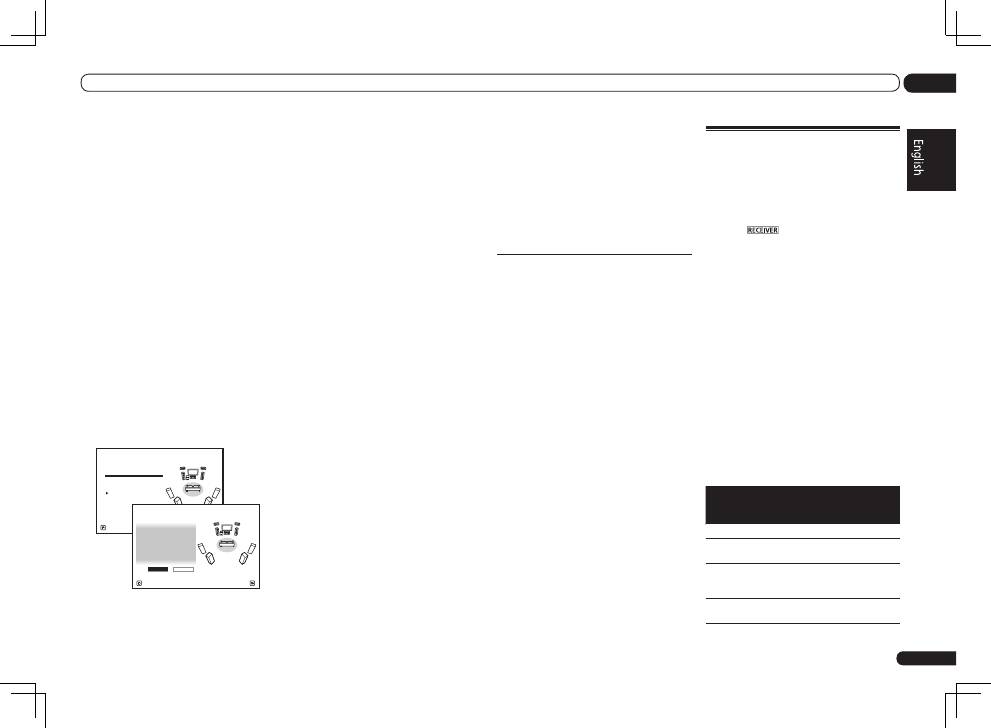
En
17
03
Basic Setup
5 Follow the instructions on-screen.
Make sure the microphone is connected, and
if you’re using a subwoofer, make sure it is
switched on and set to a comfortable volume
level.
6 Wait for the test tones to finish, then
confirm the speaker configuration in the
GUI screen.
A progress report is displayed on-screen while
the receiver outputs test tones to determine
the speakers present in your setup. Try to be as
quiet as possible while it’s doing this.
If no operations are performed for 10 seconds
while the speaker configuration check screen
is being displayed, the Full Auto MCACC Setup
will resume automatically. In this case, you
don’t need to select ‘
OK
’ and press
ENTER
in
step 7.
!
With error messages (such as
Too much
ambient noise!
or
Check microphone.
),
select
RETRY
after checking for ambient
noise (see
Problems when using the Auto
MCACC Setup
on page 17 ) and verifying the
mic connection. If there doesn’t seem to be
a problem, you can simply select
GO NEXT
and continue.
Now Analyzing...
2/9
Environment Check
1a.Full Auto MCACC
A/V RECEIVER
Exit
Cancel
Ambient Noise
: OK
Microphone
:
Speaker YES/NO :
L
:
YES
FHL
:
YES
C
:
YES
FHR
:
YES
R
:
YES
SR
:
YES
SBR :
YES
SBL
:
YES
SL
:
YES
SW
:
YES
1a.Full Auto MCACC
10
OK
RETRY
A/V RECEIVER
Exit
Cancel
The configuration shown on-screen should
reflect the actual speakers you have.
!
If you see an
ERR
message (or the speaker
configuration displayed isn’t correct),
there may be a problem with the speaker
connection. If selecting
RETRY
doesn’t work,
turn off the power and check the speaker
connections. If there doesn’t seem to be a
problem, you can simply use
i
/
j
to select
the speaker and
k
/
l
to change the setting
and continue.
!
If the speaker is not pointed to the
microphone (listening position) or when
using speakers that affect the phase
(dipole speakers, reflective speakers, etc.),
Reverse Phase
may be displayed even if the
speakers are properly connected.
If
Reverse Phase
is displayed, the speaker’s
wiring (+ and –) may be inverted. Check the
speaker connections.
—
If the connections were wrong, turn off
the power, disconnect the power cord,
then reconnect properly. After this,
perform the Full Auto MCACC procedure
again.
—
If the connections were right, select
GO NEXT
and continue.
7 Make sure ‘OK’ is selected, then press
ENTER.
A progress report is displayed on-screen while
the receiver outputs more test tones to deter-
mine the optimum receiver settings.
Again, try to be as quiet as possible while this is
happening. It may take 3 to 10 minutes.
8 The Full Auto MCACC Setup procedure
is completed and the Home Menu menu
reappears automatically.
Be sure to disconnect the microphone from
this receiver upon completion of the Full Auto
MCACC Setup.
!
Depending on the characteristics of your
room, sometimes identical speakers with
cone sizes of around 12 cm will end up with
different size settings. You can correct the
setting manually using the
Manual speaker
setup
on Operating Instructions in CD-ROM.
!
The subwoofer distance setting may be
farther than the actual distance from the
listening position. This setting should
be accurate (taking delay and room
characteristics into account) and generally
does not need to be changed.
!
If Full Auto MCACC Setup measurement
results are incorrect due to the interaction of
the speakers and viewing environment, we
recommend adjusting the settings manually.
Problems when using the Auto
MCACC Setup
If the room environment is not optimal for the
Auto MCACC Setup (too much background
noise, echo off the walls, obstacles blocking
the speakers from the microphone) the final
settings may be incorrect. Check for household
appliances (air conditioner, fridge, fan, etc.),
that may be affecting the environment and
switch them off if necessary. If there are any
instructions showing in the front panel display,
please follow them.
!
Some older TVs may interfere with the
operation of the microphone. If this seems to
be happening, switch off the TV when doing
the Auto MCACC Setup.
Operation Mode Setup
This receiver is equipped with a great number
of functions and settings. The Operation Mode
feature is provided for users who find it difficult
to master all these functions and settings.
One of two settings can be selected for the
Operation Mode
:
Expert
and
Basic
.
1 Press
on the remote control,
then press HOME MENU.
A Graphical User Interface (GUI) screen
appears on your TV. Use
i
/
j
/
k
/
l
and
ENTER
to navigate through the screens and
select menu items. Press
RETURN
to exit the
current menu.
2 Select ‘Operation Mode Setup’ from
the Home Menu.
3 Select the Operation Mode setting you
want.
!
Expert
(default) – Users can set all the
functions by themselves.
!
Basic
– The number of operable functions is
restricted, and functions whose operations
are restricted are automatically set to achieve
the Pioneer-recommended sound and
picture quality. The functions that can be
operated are shown below. They can be set
as necessary by referring to the operating
instructions.
Operable
functions/
items
Descriptions
Page
HOME MENU
Full Auto
MCACC
Makes high precision
sound field settings easily.
16
Input Name
Input names can be
changed as desired for
easier use.
*1
Input Skip
Inputs not being used are
skipped (not displayed).
*1

En
18
03
Basic Setup
Operable
functions/
items
Descriptions
Page
Software
Update
Updates to the latest ver-
sion of the software.
*1
Network
Information
Checks the receiver’s IP
address.
*1
Pairing
Bluetooth
Setup
Pairs with a Bluetooth
device using AS-BT100 or
AS-BT200.
*1
Audio Parameters
MCACC
(MCACC
preset)
Selects your favorite
MCACC preset memory.
*1
DELAY
(Sound Delay)
Adjusts the delay time of
the overall sound.
*1
S.RTRV
(Auto Sound
Retriever)
Plays compressed sound
with high sound quality.
*1
DUAL
(Dual Mono)
Dual monaural audio
setting.
*1
V.SB
(Virtual Sur-
round Back)
Creates a virtual surround
back channel sound for
playback.
*1
V.HEIGHT
(Virtual
Height)
Creates a virtual height
channel sound for play-
back.
*1
Other functions
INPUT
SELECT
(
INPUT
SELECTOR
)
Switches the input.
19
MASTER
VOLUME
+
/
–
,
MUTE
Use to set the listening
volume.
19
LISTENING
MODE
Only Pioneer-recommended
modes can be selected.
19
PQLS
Plays using the PQLS
function.
*1
PHASE CTRL
(Phase Con-
trol)
Plays with phase shifting in
the low range corrected.
*1
Operable
functions/
items
Descriptions
Page
SOUND
RETRIEVER
AIR
Switches the input to
ADAPTER PORT
and plays
compressed sound with
high sound quality.
*1
iPod iPhone
iPad DIRECT
CONTROL
Switches the input to
iPod/
USB
and sets the mode
allowing operation from
the iPod.
*1
1 See the Operating Instructions in CD-ROM for
detail.
4 When you’re finished, press RETURN.
You will return to the
Home Menu
.
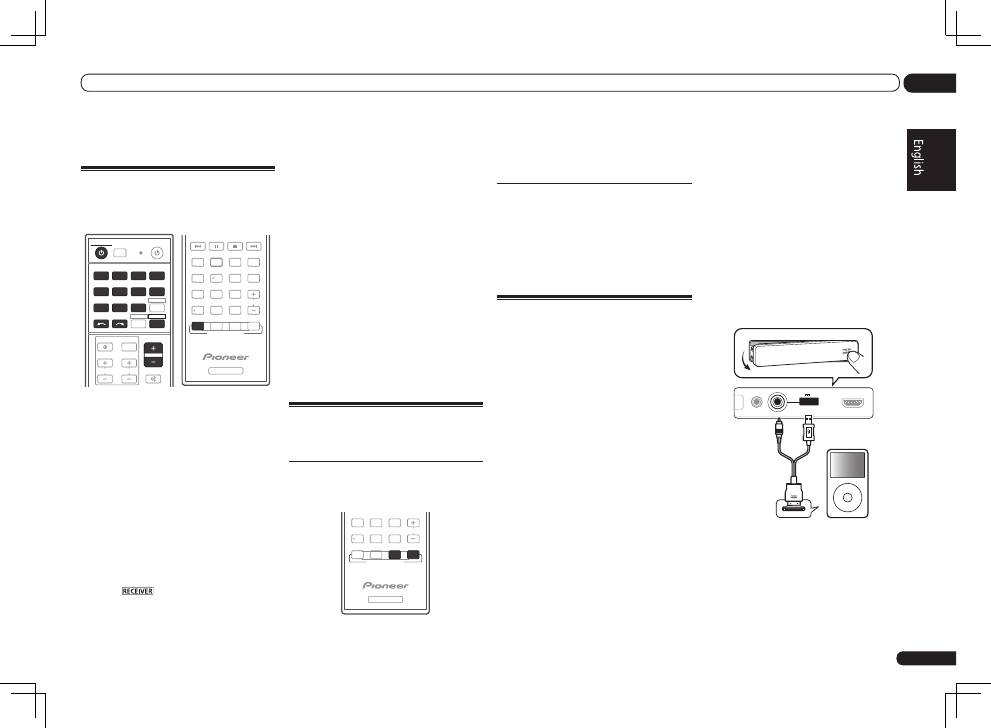
En
19
04
Basic playback
Basic playback
Playing a source
Here are the basic instructions for playing a
source (such as a DVD disc) with your home
theater system.
CH
TV CONTROL
INPUT
INPUT SELECT
iPod
USB
TUNER
VIDEO
ADPT
HMG
CD
TV
RCU SETUP
SOURCE
RECEIVER
MULTI
OPERATION
BDR
SAT
BD
DVD
DVR
HDMI
RECEIVER
TV CTRL
ZONE2
MUTE
MASTER
VOLUME
VOL
RECEIVER
D.ACCESS
CH LEVEL A.ATT
LISTENING MODE
DIMMER
SIGNAL SEL MCACC SLEEP
MIDNIGHT
TV / DTV
MPX
PQLS
AUTO / ALC /
DIRECT
STEREO STANDARD ADV SURR
AUDIO
INFO
CLASS
ENTER
DISP
5
4
6
8
0
7
9
1
3
/ CLR
CH
22
S.RETRIEVER
2
1 Switch on your system components
and receiver.
Start by switching on the playback compo-
nent (for example a DVD player), your TV and
subwoofer (if you have one), then the receiver
(press
u
RECEIVER
).
Make sure that the TV’s video input is set to this
receiver.
2 Select the input function you want to
play.
You can use the input function buttons on the
remote control,
INPUT SELECT
, or the front
panel
INPUT SELECTOR
dial.
!
If you need to manually switch the input
signal type press
SIGNAL SEL
.
3 Press
to the receiver operation
mode.
4 Press AUTO/ALC/DIRECT
(AUTO SURR/ALC/STREAM DIRECT) to
select ‘AUTO SURROUND’ and start
playback of the source.
If you’re playing a Dolby Digital or DTS surround
sound source, you should hear surround sound.
If you are playing a stereo source, you will only
hear sound from the front left/right speakers in
the default listening mode.
!
You may need to check the digital audio
output settings on your DVD player or digital
satellite receiver. It should be set to output
Dolby Digital, DTS and 88.2 kHz / 96 kHz PCM
(2 channel) audio, and if there is an MPEG
audio option, set this to convert the MPEG
audio to PCM.
5 Use the MASTER VOLUME +/– to adjust
the volume level.
Listening in surround sound
Using this receiver, you can listen to any source
in surround sound.
Standard surround sound
This receiver provide basic surround sound for
stereo and multichannel sources.
RECEIVER
D.ACCESS
CH LEVEL A.ATT
LISTENING MODE
DIMMER
AUTO / ALC /
DIRECT
STEREO
STANDARD ADV SURR
CLASS
ENTER
8
0
7
9
/ CLR
CH
%
While listening to a source, press
STANDARD (STANDARD SURROUND).
If necessary, press repeatedly to select a listen-
ing mode.
Using the Advanced surround
effects
The Advanced surround effects can be used for
a variety of additional surround sound effects.
%
Press ADV SURR
(ADVANCED SURROUND) repeatedly to
select a listening mode.
Playing an iPod
This receiver has the
iPod iPhone iPad USB
terminal that will allow you to control playback
of audio content from your iPod using the con-
trols of this receiver.
!
This receiver is compatible with the audio
and video of the iPod nano (audio only for the
iPod nano 1G/2G), iPod fifth generation (audio
only), iPod classic, iPod touch, iPhone and
iPad. However, some of the functions may be
restricted for some models. The receiver is not
compatible with the iPod shuffle.
!
This receiver has been developed and tested
for the software version of iPod/iPhone/iPad
indicated on the website of Pioneer (http://
pioneer.jp/homeav/support/ios/eu/).
!
Installing software versions other than
indicated on the website of Pioneer to your
iPod/iPhone/iPad may result in incompatibility
with this receiver.
!
iPod, iPhone and iPad are licensed for
reproduction of non-copyrighted materials
or materials the user is legally permitted to
reproduce.
!
Features such as the equalizer cannot
be controlled using this receiver, and we
recommend switching the equalizer off before
connecting.
!
Pioneer cannot under any circumstances
accept responsibility for any direct or indirect
loss arising from any inconvenience or loss
of recorded material resulting from the iPod
failure.
!
When listening to a track on the iPod in the
main zone, it is possible to control the sub
zone, but not to listen to a different track in
the sub zone from the one playing in the main
zone.
1 Switch the receiver into standby then
use the supplied iPod cable to connect
your iPod to the iPod iPhone iPad USB
terminal on the front panel of this
receiver.
In case of VSX-1021
MCACC
SETUP MIC
iPod
iPhone
iPad
USB
5V 2.1 A
HDMI 2 INPUT
MENU
CONTROL
ON / OFF
iPod
iPod cable
(supplied)

En
20
04
Basic playback
5 Use
i
/
j
and ENTER to select the track
to be played, then press the
d
button.
Basic playback controls
!
Press
iPod USB
to switch the remote control
to the iPod/USB operation mode.
iPod CTRL
HOME
MENU TUNE
TUNE TOOLS
LIST
PRESET
TOP MENU
BAND
GUIDE
T.EDIT
VIDEO
PARAMETER
AUDIO
PARAMETER
ENTER
PRESET
RETURN
PTY
SEARCH
SIGNAL SEL MCACC SLEEP
TV / DTV
MPX
PQLS
PHASE CTRL
STATUS
PGM
MENU
AUDIO
INFO
DISP
HDD
DVD
5
4
6
1
3
22
S.RETRIEVER
2
Listening to the radio
1 Press TUNER to select the tuner.
2 Use BAND to change the band (FM or
AM), if necessary.
3 Tune to a station.
There are three ways to do this:
!
Automatic tuning
– Press and hold
TUNE
i
/
j
for about a second. The receiver will
start searching for the next station.
!
Manual tuning
– To change the frequency
one step at a time, press
TUNE
i
/
j
.
!
High speed tuning
– Press and hold
TUNE
i
/
j
for high speed tuning. Release the
button at the frequency you want.
Improving FM sound
If the
TUNED
or
STEREO
indicator doesn’t
light when tuning to an FM station because the
signal is weak, press
MPX
to switch the receiver
into mono reception mode.
Using Neural Surround
This feature uses Neural Surround
TM
technolo-
gies to achieve optimal surround sound from
FM radio.
!
While listening to FM radio, press
AUTO/ALC/DIRECT
for Neural Surround.
!
The
Neural Surround
mode can be selected
also with
STANDARD
.
Saving station presets
If you often listen to a particular radio station,
it’s convenient to have the receiver store the
frequency for easy recall whenever you want to
listen to that station.
1 Tune to a station you want to
memorize.
2 Press T.EDIT (TUNER EDIT).
The display shows
PRESET MEMORY
, then a
blinking memory class.
3 Press CLASS to select one of the seven
classes, then press PRESET
k
/
l
to select
the station preset you want.
4 Press ENTER.
After pressing
ENTER
, the preset class and
number stop blinking and the receiver stores
the station.
Listening to station presets
1 Press TUNER to select the tuner.
2 Press CLASS to select the class in which
the station is stored.
3 Press PRESET
k
/
l
to select the
station preset you want.
In case of VSX-921
MCACC
SETUP MIC
L AUDIO R
VIDEO
VIDEO 2 INPUT
iPod
iPhone
iPad
USB
5V 2.1 A
MENU
CONTROL
ON / OFF
iPod
iPod cable
(supplied)
2 Press
u
RECEIVER to switch on the
receiver and your TV.
3 Press iPod USB on the remote control
to switch the receiver to the iPod/USB.
4 Use
i
/
j
to select ‘Music’ from the
iPod Top menu.
5 Use
i
/
j
and ENTER to select the track
to be played, then press the
d
button.
Basic playback controls
!
Press
iPod USB
to switch the remote control
to the iPod/USB operation mode.
iPod CTRL
HOME
MENU TUNE
TUNE TOOLS
LIST
PRESET
TOP MENU
BAND
GUIDE
T.EDIT
VIDEO
PARAMETER
AUDIO
PARAMETER
ENTER
PRESET
RETURN
PTY
SEARCH
SIGNAL SEL MCACC SLEEP
TV / DTV
MPX
PQLS
PHASE CTRL
STATUS
PGM
MENU
AUDIO
INFO
DISP
HDD
DVD
5
4
6
1
3
22
S.RETRIEVER
2
Playing a USB device
It is possible to play files using the USB inter-
face on the front of this receiver.
!
Compatible USB devices include external
magnetic hard drives, portable flash memory
drives (particularly key drives) and digital audio
players (MP3 players) of format FAT16/32.
!
Pioneer cannot guarantee compatibility
(operation and/or bus power) with all USB
mass storage devices and assumes no
responsibility for any loss of data that may
occur when connected to this receiver.
1 Switch the receiver into standby
then connect your USB device to the
USB terminal on the front panel of this
receiver.
CONTROL
ON / OFF
MCACC
SETUP MIC
iPod
iPhone
iPad
USB
5V 2.1 A
HDMI 2 INPUT
USB mass
storage device
2 Press
u
RECEIVER to switch on the
receiver and your TV.
!
Make sure the receiver is in standby when
disconnecting the USB device.
3 Press iPod USB on the remote control
to switch the receiver to the iPod/USB.
4 Use
i
/
j
to select ‘Music’ from the
USB Top menu.

